Brazilian wandering spiders: Bites & other facts
Brazilian wandering spiders don't build webs but crawl on the forest floor at night in search of prey, which they kill with neurotoxic venom.
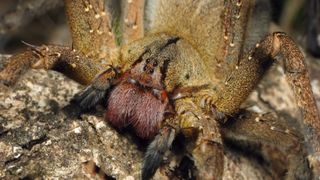

Classification/taxonomy
Size & characteristics, bites and venom, additional resources.
Brazilian wandering spiders are aggressive spiders that belong to the genus Phoneutria, which means "murderess" in Greek.
These critters, also known as armed spiders or banana spiders, are some of the most venomous spiders on Earth. Their large mouthparts, or chelicerae, inflict painful bites loaded with neurotoxic venom that can be deadly to humans — especially children — although in most cases immediate medical care can prevent death with antivenom, according to a 2018 study in the journal Clinical Toxinology in Australia, Europe, and Americas .
Brazilian wandering spiders are frequently listed among the deadliest spiders in the world . They were named the world's deadliest spiders multiple times by Guinness World Records, although the current record-holder is the male Sydney funnel-web spider ( Atrax robustus ). But "classifying an animal as deadly is controversial," Jo-Anne Sewlal, an arachnologist at the University of the West Indies in Trinidad and Tobago, previously told Live Science. Each bite is unique, and the damage it causes depends on the amount of venom injected, Sewlal said.
Jo-Anne Sewlal was a noted arachnologist from Trinidad and Tobago. While completing her PhD, she received the National Institute of Higher Education, Research, Science and Technology (NIHERST) 2012 Award for Excellence in Science and Technology for Junior Scientist. In 2013, She received a doctorate in zoology from the University of the West Indies. She discovered several species of spiders in her home country, surveyed the arachnids across several countries the Caribbean and appeared as an expert on the topic on The Science Channel. She died of an allergic reaction in January 2020.
There are nine species of Brazilian wandering spider, all of which are nocturnal and can be found in Brazil. Some species also can be found throughout Central and South America, from Costa Rica to Argentina, according to a 2008 article in the journal American Entomologist . Study author Richard S. Vetter , a research associate in the department of entomology at the University of California, Agriculture and Natural Resources, wrote that specimens of these powerful arachnids have been mistakenly exported to North America and Europe in banana shipments. However, Vetter noted, in many cases of cargo infestation, the spider in question is a harmless banana spider (genus Cupiennius ) that is misidentified as a Phoneutria . The two types of spiders look similar.
The taxonomy of Brazilian wandering spiders, according to the Integrated Taxonomic Information System (ITIS) , is:
Kingdom : Animalia
Subkingdom : Bilateria
Infrakingdom : Protostomia
Superphylum : Ecdysozoa
Phylum : Arthropoda
Subphylum : Chelicerata
Class : Arachnida
Order : Araneae
Family : Ctenidae
Genus : Phoneutria
- Phoneutria bahiensis
- Phoneutria boliviensis
- Phoneutria eickstedtae
- Phoneutria fera
- Phoneutria keyserlingi
- Phoneutria nigriventer
- Phoneutria pertyi
- Phoneutria reidyi
- Phoneutria depilata , according to a 2021 study published in the journal ZooKeys , which found that Phoneutria boliviensis actually included two separate species from different habitats.
Brazilian wandering spiders are large, with bodies reaching up to 2 inches (5 centimeters) and a leg span of up to 7 inches (18 cm), according to the Natural History Museum in Karlsruhe, Germany. The species vary in color, though all are hairy and mostly brown and gray, although some species have lightly colored spots on their abdomen. Many species have bands of black and yellow or white on the underside of the two front legs, according to the University of Florida .
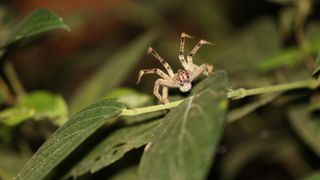
These arachnids "are called wandering spiders because they do not build webs but wander on the forest floor at night, actively hunting prey," Sewlal told Live Science in an interview conducted in 2014, before her death. They kill by both ambush and direct attack.
They spend most of their day hiding under logs or in crevices, and come out to hunt at night. They eat insects, other spiders and sometimes, small amphibians, reptiles and mice.
Research into one species of Brazilian wandering spider, Phoneutria boliviensis , revealed that these spiders eat a mix of arthropods and reptiles. DNA metabarcoding, a technique that examines the DNA and RNA in a sample, of the guts of 57 spiders identified 96 prey species, including flies, beetles, butterflies, moths, grasshoppers, locusts and crickets, according to research from the University of Tolima and the University of Ibagué in Colombia . Some of the female spiders also ate lizards and snakes.
While their bites are powerful and painful, "their bites are a means of self-defense and only done if they are provoked intentionally or by accident," Sewlal said.
When Brazilian wandering spiders feel threatened, they often assume a defensive position by standing on their hind legs and stretching out their front legs to expose their fangs, according to the 2018 study in Clinical Toxinology in Australia, Europe, and Americas. This posture is sometimes accompanied by side-to-side movements. The spiders can also jump distances up to 1.3 feet (40 cm).

In the Brazilian wandering spider, just as in most spider species, the female is larger than the male. Males approach females cautiously when attempting to mate, according to the biology department at the University of Wisconsin-La Crosse . Males perform a dance to get females' attention, and males often fight each other over the female. The female can be picky, and she often turns down many males before choosing a mating partner. Once she does pick one, the male needs to watch out; females often attack the males once copulation is finished.
The female then can store the sperm in a separate chamber from the eggs until she is ready to fertilize them. She will lay up to 1,000 eggs at a time, which are kept safe in a spun-silk egg sac.
Brazilian wandering spiders typically live for one or two years.
Brazilian wandering spiders' venom is a complex cocktail of toxins, proteins and peptides, according to the Natural History Museum in Karlsruhe, Germany. The venom affects ion channels and chemical receptors in victims' neuromuscular systems.
After a human is bitten by one of these spiders, they may experience initial symptoms such as severe burning pain at the site of the bite, sweating and goosebumps, Sewlal said. Within 30 minutes, symptoms become systemic and include high or low blood pressure , fast or a slow heart rate , nausea, abdominal cramping, hypothermia, vertigo, blurred vision, convulsions and excessive sweating associated with shock. People who are bitten by a Brazilian wandering spider should seek medical attention immediately.
Their venom is perhaps most famous for triggering painful and long-lasting erections . For that reason, in a 2023 study, scientists reported that they were testing the venom in humans as a potential treatment for erectile dysfunction in those for whom Viagra didn't work.

However, these bites are rare, and envenomations, or exposure to these toxins from a spider bite, are usually mild, Vetter said. For instance, a 2000 study in the journal Revista do Instituto de Medicina Tropical de São Paulo found that only 2.3% of people with bites who came to a Brazilian hospital over a 13-year period were treated with antivenom. (The other bites did not contain enough venom to require it.) Most of the bites were from the species P. nigriventer and P. keyserlingi in eastern coastal Brazil. About 4,000 bites reportedly happen each year in Brazil, but only 0.5% of those cases are severe, according to the 2018 study. Meanwhile, 15 deaths have been attributed to Phoneutria in Brazil since 1903, the 2018 study reported.
"It is unlikely that the spider would inject all of its venom into you, as this venom is not only needed as a means of defense but to immobilize prey," Sewlal said. "So if it did inject all of its venom, it [would] have to wait until its body manufactured more before it could hunt." That would also leave the spider vulnerable to being attacked by predators.
Furthermore, Sewlal pointed out that venom production requires a lot of a spider's resources and time. "So if the spider were to attack frequently and use up all of its venom, it [would] be safe to assume that it has a ready food supply to replace the energy and resources used. This situation does not exist in the wild."
- Learn more about Brazilian wandering spiders from the University of Wisconsin-La Crosse .
- Read about several species of Brazilian wandering spiders, including several images of the arachnids at the University of Florida .
- Find a spider in your bananas? It may or may not be a deadly species, according to the University of California, Riverside .
This article was originally published on Nov. 20, 2014.
Sign up for the Live Science daily newsletter now
Get the world’s most fascinating discoveries delivered straight to your inbox.
Jessie Szalay is a contributing writer to FSR Magazine. Prior to writing for Live Science, she was an editor at Living Social. She holds an MFA in nonfiction writing from George Mason University and a bachelor's degree in sociology from Kenyon College.
- Laura Geggel Editor
- Sascha Pare Trainee staff writer
Giant, invasive Joro spiders with 6-foot webs could be poised to take over US cities, scientists warn
Diving bell spider: The only aquatic arachnid that creates a web underwater to live in
Explosive 'devil comet' grows seemingly impossible 2nd tail after close flyby of Earth — but it's not what it seems
Most Popular
- 2 'She is so old': One-eyed wolf in Yellowstone defies odds by having 10th litter of pups in 11 years
- 3 Stunning 'parade of planets' image shows 6 worlds aligned over Earth
- 4 100-foot 'walking tree' in New Zealand looks like an Ent from Lord of the Rings — and is the lone survivor of a lost forest
- 5 A 'new star' could appear in the sky any night now. Here's how to see the Blaze Star ignite.
- 2 Save $400 on Unistellar's new smart binoculars during their early bird Kickstarter
- 3 What is the 3-body problem, and is it really unsolvable?
- 4 Razor-thin silk 'dampens noise by 75%' — could be game-changer for sound-proofing homes and offices
- 5 'The blade of the sword was still sharp': Lost metal detectorist discovers Bronze Age sword and ax in UK

Understanding the Wandering Spider: Quick Essential Facts
Wandering spiders are a group of venomous arachnids found primarily in South America.
Among these, the Brazilian wandering spider is particularly known for its potent venom and unique behavior. They are often referred to as “banana spiders” due to their frequent encounters with humans in banana plantations.
As a reader, you might be interested in learning more about these fascinating creatures, including their habitat, hunting techniques, and the effects of their venom.
In this article, we will delve into the world of wandering spiders and provide you with all the essential information to satisfy your curiosity.

Scientific Classification and Naming
The wandering spider belongs to the genus Phoneutria , which is a part of the Ctenidae family.
These spiders are known for their potent venom and aggressive behavior. Here is the scientific classification of the wandering spider:
- Kingdom: Animalia
- Phylum: Arthropoda
- Subphylum: Chelicerata
- Class: Arachnida
- Order: Araneae
- Family: Ctenidae
- Genus: Phoneutria
Within the genus Phoneutria, two species are particularly noteworthy: Phoneutria fera and Phoneutria nigriventer, also known as P. nigriventer . These spiders are primarily found in South America and other tropical regions.
Phoneutria fera and P. nigriventer differ in some aspects. Let’s compare their features using a table:
Some key characteristics of the wandering spiders in the genus Phoneutria include:
- Potent venom that can be dangerous to humans
- Nocturnal hunters and are active at night
- Equipped with long, spiny legs for capturing prey
- Aggressive defenders of their territory
By understanding the scientific classification and differences between Phoneutria species, you can better appreciate the diversity and fascinating biology of these wandering spiders.
Identification and Appearance
Color and size.
The wandering spider, also known as the banana spider, has a distinctive appearance that can help you easily identify it in the wild.
They usually have a combination of hairy brown and black colors on their body. Their size can vary, but they are generally considered large spiders. Their size can range from 1 to 2 inches in body length.

When it comes to wandering spider’s leg span, these creatures can have an impressive reach. Their leg span can extend up to 5-6 inches.
Some key characteristics of a wandering spider’s legs include:
Habitat and Distribution
Wandering Spiders are known to inhabit various environments, including rainforests and tropical forests.
These spiders can adapt to different habitats based on their needs and availability of food sources. They prefer warm and humid places, as these conditions suit their growth and reproduction.
Geographical Coverage
Wandering spiders are found in Central and South America .
They live in forests from Costa Rica to Argentina, including Colombia, Venezuela, The Guianas, Ecuador, Peru, Bolivia, Brazil, Paraguay, and Northern Argentina.
They may also be present in some parts of the United States, particularly in the northern part of southern America.
However, they don’t inhabit countries like Australia. In summary, the Wandering Spider is mostly prevalent in the following areas:
- South America
- Central America
- Southern parts of the United States
Types of Wandering Spiders
Here’s a brief description of the major types of wandering spiders.
Brazilian wandering spiders
Also known as armed or banana spiders, these spiders are nocturnal and don’t make webs.
They are known to have been transported outside of South America in banana shipments.
Phoneutria nigriventer
These spiders contain neurotoxins that can cause cerebral changes and breakdown of the blood-brain barrier .
Their venom is medically significant and has been used in manufacturing drugs. Their bites may be fatal to children.
Ctenus captiosus
Also known as the Florida false wolf spider or tropical wolf spider, this species is found in the United States.
Some species of these spiders are large and scary-looking, but they’re only mildly venomous. Their venom is comparable to a bee sting.
Other types of wandering spiders include: Acantheis, Acanthoctenus, Africactenus, and Afroneutria.

Behavior and Diet
Aggression level.
Wandering spiders, as their name suggests, are known for their aggressive behavior .
While they won’t attack without provocation, if they feel threatened, they will not hesitate to defend themselves.
This is especially true during mating season.
Prey and Predators
In their natural habitat, wandering spiders primarily feed on insects and small vertebrates, such as:
- Insects like ants and moths
- Small amphibians
This diverse diet allows them to thrive in various ecosystems.
However, they are not top predators, as their natural predators include larger birds, mammals, and other spiders.
Nocturnal Activities
Wandering spiders are nocturnal creatures , which means they are active during the night.
During the day, they remain hidden in their retreats, often made from rolled-up leaves or small crevices.
At night, they leave their hiding spots to search for prey using their strong hunting skills.

Venom and Its Effects
Composition of venom.
The venom of the wandering spider is a complex mixture containing several toxic components.
Its main component is a potent neurotoxin, which can have severe effects on your nervous system 1 . Here’s a brief overview of its composition:
- Neurotoxins
Symptoms and Severity
A wandering spider’s venomous bite can cause a wide range of symptoms, depending on the severity of envenomation. These symptoms may include 2 :
- Mild to moderate pain
- Redness and swelling at the bite site
- Irregular heartbeat
- Difficulty breathing
- Blurred vision
- High blood pressure
Some severe cases may result in life-threatening complications, such as respiratory failure or even death 2 .
Medical Treatment and Antivenom
If bitten by a wandering spider, it’s crucial to seek immediate medical attention. Treatment often involves the following steps:
- Cleaning and immobilizing the affected area
- Monitoring and managing the symptoms
- Administering antivenom if it’s available and appropriate, depending on the severity of envenomation 3
Antivenom is specific to the venom of the wandering spider and can help neutralize its effects.
However, the availability of antivenom may be limited in some regions 3 .
Always remember that prevention is better than cure: learning how to identify and avoid wandering spiders is the best way to stay safe.

Reproduction and Mating
Mating ritual.
When it’s time for reproduction, the wandering spider undergoes an intriguing mating ritual.
The male spider performs a dance to attract the female by displaying his brightly colored legs and vibrating his body.
During the process, the male also produces a sperm web and transfers his sperm to the female’s reproductive organs using his pedipalps.
Egg Sacs and Offspring
After the mating process, the female wandering spider will create an egg sac to protect her eggs.
The sac consists of silk and can hold hundreds of eggs. She then attaches it to a safe hiding place, usually against a protective surface or within a secure web.
The female often guards the egg sac to ensure the protection of her offspring until they hatch.
Once the spiderlings hatch, they are known to be highly independent.
They disperse quickly and start their own journey, fending for themselves soon after emerging from the egg sac.
As they grow, they’ll go through a series of molts before reaching adulthood and beginning their own reproductive cycle.
Danger and Defense Mechanisms
The Wandering Spider is known to be one of the most dangerous spiders in the world.
Although they can potentially kill humans, fatalities are rare due to their reluctance to bite.
Oddly enough, their venom can cause an involuntary erection in men, alongside other painful symptoms.
Here are some ways the Wandering Spider protects itself and displays its dangerous nature:
- Fangs : These spiders are equipped with strong, sharp fangs that can easily pierce human skin, allowing them to inject their venom with ease.
- Venom : Their venom is potent and can cause severe pain, inflammation, and other adverse effects. In rare cases, it can even lead to death.
While interacting with Wandering Spiders, be cautious and observe them from a safe distance.
Knowing their defense mechanisms will help you respect their space and avoid any unpleasant encounters.
Remember, it’s essential to be informed and aware when dealing with these fascinating, yet dangerous creatures.

Comparison with Other Dangerous Spiders
Comparison to black widow.
The black widow spider is notorious for its potent venom, but the wandering spider has a stronger venom overall.
Both spiders are capable of causing severe symptoms, but the black widow’s venom is primarily neurotoxic, affecting your nervous system.
In contrast, the wandering spider’s venom can cause both neurotoxic and cytotoxic effects, potentially damaging your nerves and cells.
- Potent neurotoxic venom
- Red hourglass marking
- Stronger venom (neurotoxic and cytotoxic)
- No distinct marking
Comparison to Brown Recluse
The brown recluse spider is known for its necrotic venom that can lead to tissue damage and sometimes requires medical intervention.
While both the brown recluse and wandering spider can produce venomous bites, wandering spiders are considered more dangerous due to the potency of their venom and the severity of their bite symptoms.
- Necrotic venom
- Dark violin-shaped marking
Comparison to Wolf Spider
Wolf spiders are frequently mistaken for more dangerous spiders due to their size and appearance.
Although they can bite, their venom is not particularly potent and generally only causes mild itching, redness, and swelling.
In comparison, the wandering spider’s venom is far more dangerous, and its bite can result in serious symptoms, requiring immediate medical attention.
- Large and hairy
- Smoother appearance
Comparison to Sydney Funnel-Web Spider
The Sydney funnel-web spider is another highly venomous spider known for its potentially lethal bites.
While both spiders possess powerful venom, the wandering spider has a broader range of symptoms due to the combination of neurotoxic and cytotoxic effects.
In conclusion, wandering spiders are more dangerous than wolf spiders but their venom’s effects are more varied compared to black widows, brown recluses, and Sydney funnel-web spiders.
Be cautious around these spiders and seek medical help if bitten.
Interesting Facts and Guinness World Records
The Wandering Spider, also known as the Brazilian Wandering Spider, is a fascinating creature that has caught the attention of many.
They belong to the genus Phoneutria , which means “murderess” in Greek, giving you an idea of their potency. Let’s explore some interesting facts about this spider and its place in the Guinness World Records.

First, you might be curious about their venom. The Wandering Spider is known for having one of the most potent venoms among spiders.
In fact, it holds the Guinness World Record for the most venomous spider. Their venom contains a potent neurotoxin that can cause severe symptoms, including difficulty breathing, high blood pressure, and intense pain.
Apart from their venom, their behavior is also quite intriguing. These spiders are called “wandering” because they are known for actively hunting their prey rather than spinning webs to catch them.
They are mostly nocturnal creatures and, during the day, can be found hiding in logs or dark crevices.
Here are a few more notable characteristics of the Wandering Spider:
- Females are larger than males, with a body length of up to 1.6 inches (4 cm).
- They have eight eyes, arranged in two rows, which help them in hunting.
- The Wandering Spider is primarily found in Central and South America, particularly in Brazil.
- They are known to show aggression when threatened.
While the Wandering Spider is a marvel of the arachnid world, it’s essential to keep a safe distance from them due to their venomous nature.
However, their unique characteristics and record-breaking venom potency make them a fascinating subject for those interested in the natural world.
Prevention and Safety Measures
To protect yourself from wandering spiders, there are some simple safety measures you can take.
Firstly, be cautious in areas where these spiders may live, such as dark and warm spaces. For example, avoid reaching into crevices or lifting piles of wood without inspecting them first.
Always wear appropriate shoes when outdoors, particularly in wooded or grassy areas. This can help prevent bites on your feet or ankles.
Reduce the risk of wandering spiders entering your home by sealing gaps and cracks. This minimizes the chance of the spiders finding a way inside.
Regularly clean your living spaces, paying special attention to dark and hidden areas. By maintaining a clean environment, you’ll discourage wandering spiders from making themselves at home.
When out in nature, avoid disturbing spider habitats like webs or egg sacs. This can prevent agitating wandering spiders, reducing your chance of accidental encounters.
Remember, wandering spiders can be dangerous, but by taking these precautions, you can significantly reduce your risk of encountering them or being bitten. Stay safe and always be aware of your surroundings.
In summary, wandering spiders, particularly those in the genus Phoneutria, are a group of venomous arachnids predominantly found in Central, South America and parts of Southern United States.
These spiders, including the Brazilian wandering spider, are known for their potent venom, nocturnal hunting habits, and aggressive defense mechanisms.
Their venom, containing neurotoxins and other components, can cause severe symptoms in humans, making them one of the most dangerous spider species.
Despite their fearsome reputation, fatalities are rare, and they play a vital role in their ecosystems.
It’s important to respect their space and take preventive measures to avoid encounters. Understanding these spiders’ behavior, habitat, and characteristics can help in appreciating their role in nature while ensuring safety.
https://www.ncbi.nlm.nih.gov/pmc/articles/PMC2857337/ ↩
https://www.ncbi.nlm.nih.gov/pmc/articles/PMC3851068/ ↩ ↩ 2
https://www.ncbi.nlm.nih.gov/pmc/articles/PMC6560916/ ↩ ↩ 2
Reader Emails
Over the years, our website, whatsthatbug.com has received hundreds of letters and some interesting images asking us about wandering spiders. Scroll down to have a look at some of them.
Letter 1 – Wandering Spider from Ecuador

Hi Michele, There is a resemblance to the Dolomedes Fishing Spiders, and finding it near a river lends credence to that possibility. Eric Eaton noticed this posting and has this to say: ” Ok, the spiders from Ecuador and Costa Rica: They are most likely NOT wolf spiders, but wandering spiders, either in the family Ctenidae or Sparassidae. They tend to be more common, and even larger than, wolf spiders in the tropics. At least one species, Phoneutria fera, is extremely aggressive, with potentially deadly venom. Do not mess with large spiders in Central and South America! The venomous types are very difficult to distinguish from harmless species, and in any event, a bite is going to be really painful. These spiders sometimes stow away in bananas, houseplants, and other exported goods, so they can show up in odd places. Be careful where you put your hands.”
Update: May 14, 2013 We now have a confirmation that this is a Wandering Spider, Phoneutria fera , and it is a dangerous species. See Encyclopedia Britannica and Animal Corner .
Letter 2 – Brazilian Wandering Spider: Most Venomous Animal

Hi Martin, We are happy you were able to write to us after your encounter with this Brazilian Wandering Spider and are thrilled to be able to post your story and photos to our site. We started to research, and our first hit has a different species name. Phoneutria fera is described as: “The Brazilian Wandering Spider is not for the ‘pet keeper’. Brazilian Wandering Spiders are extremely fast, extremely venomous, and extremely aggressive. These large and dangerous true spiders are ranked among the most venomous spiders known to man. In fact, the Brazilian Wandering Spider is the most venomous spider in the New World! In South America, these true spiders are commonly encountered in peoples’ homes, supposedly hiding in peoples’ shoes, hats, and other clothes. The Brazilian Wandering Spider does not remain on a web, rather, it wanders the forest floor, hence the name.” Our favorite information on Wikipedia is that Phoneutria is Greek for “murderess”. Here is one final tidbit about the effect of the bite of the Brazilian Wandering Spider on the human male .
Letter 3 – Possibly Wandering Spider from Ecuador

Dear Mike, This is really an interesting Spider, but other than to say it appears to be a hunting spider that does not build a web to entrap prey, we aren’t sure about its identity. Many hunting spiders can jump quite well. It looks very much like the spider in a posting in our archives, also from Ecuador, that we identified as possibly a Wandering Spider in the genus Phoneutria, a venomous and potentially dangerous genus . The spotted legs on your individual look like the spotted legs on an individual in an image on Wikipedia of a Wandering Spider in the genus Phoneutria . There are many images of Brazilian Wandering Spiders on Primal Shutter and we believe that might be a correct identification for your individual.
Thank you for the information. After reading more about the spider, I’m glad it didn’t jump! Mike
Letter 4 – Possibly Wandering Spider from Ecuador

Dear Carl, We believe, though we are not certain, that this might be a Wandering Spider in the genus Phoneutria, and you may read more about Wandering Spiders on the Museum für Naturkunde Karlsruhe website where it states: “There is no doubt that the venom of some of the species is quite potent for mammals, including humans.” We eagerly welcome additional opinions on this identification. Perhaps Cesar Crash of Insetologia can provide something. In the future, please submit a single species per submission form as it makes it extremely difficult for us to categorize postings with multiple species.
Letter 5 – Wandering Spider from Belize

Hi Karl, Thanks for allowing us to post your excellent image of a Wandering Spider, Cupiennius salei . The species is pictured on iNaturalist .
Bugman aka Daniel Marlos has been identifying bugs since 1999. whatsthatbug.com is his passion project and it has helped millions of readers identify the bug that has been bugging them for over two decades. You can reach out to him through our Contact Page .

Piyushi is a nature lover, blogger and traveler at heart. She lives in beautiful Canada with her family. Piyushi is an animal lover and loves to write about all creatures.
8 thoughts on “Understanding the Wandering Spider: Quick Essential Facts”
Hi Michele, I am an Ecuadorian scientist and specialized on spiders, I would like to find one like yours, I can say that, almost without doubt, you found the Phoneutria itself, it is the Phoneutria fera, look at this picture: http://www.google.com/imgres?imgurl=http://4.bp.blogspot.com/-bFH9qzT0F7U/T_2sZuk6xAI/AAAAAAAAAGY/8jnMVcPOcNI/s1600/phoneutria_fera2.jpg&imgrefurl=http://rangerbaiano.blogspot.com/2012/07/animais-peconhentos-e-venenosos.html&usg=__iCWEz7S86xub6RAyvXTER6HBaco=&h=864&w=834&sz=215&hl=es-419&start=6&zoom=1&tbnid=jjOROVO9h-vKXM:&tbnh=145&tbnw=140&ei=99eRUY6xKo2K9QTLvYCoDQ&prev=/search%3Fq%3Dphoneutria%2Bfera%26sa%3DN%26hl%3Des-US%26sout%3D1%26tbm%3Disch%26prmd%3Divns&itbs=1&sa=X&ved=0CDYQrQMwBQ Can you see the similarities?, unfortunately the spider might be in a better life today 🙂 Another thing, when you want identifications you should take a picture in front, the under part, and the upper part, as well as some characteristics about behaviour like how they react when you approach. The Phoneutria is a very agressive one.. best wishes, bye.
Hi Miguel, Thanks so much for the comment. This is a seven year old posting and we did not have the ability to post comments when it was originally posted online. We have made an update on What’s That Bug? and your comment is greatly appreciated.
Ah, there is also needed the size and the picture of its face so we can see the eye arrangement, depending on that it could also be pisauridae, but I stay in Ctenidae..
This is a female Cupiennius sp. wandering spider.
Perhaps surprisingly, this ubiquitous large spider of the Mindo area appears to be undescribed to species level.
Although one is indeed best advised to exercise caution in the presence of large ctenids, members of the genus Cupiennius are not known to be dangerously venomous (Barth, 2002). By way of confirmation, my girlfriend, Shannon Bowley, managed to be bitten by a mature female of this Mindo species in 2013 – she felt only mild effects, equivalent to a bee sting.
Thanks for this valuable information.
I’m planning a trip to Ecuador and I’m fearing these spiders. Do they get in houses? Any tips to keep them out, so I can sleep at night?
Leave a Comment Cancel reply
Save my name, email, and website in this browser for the next time I comment.
Notify me of followup comments via e-mail. You can also subscribe without commenting.
Animal Corner
Discover the many amazing animals that live on our planet.
Brazilian Wandering Spider
The Brazilian Wandering Spider (Phoneutria fera) is an aggressive and highly venomous spider . It was first discovered in Brazil hence its name. However, this genus is known to exist elsewhere in South and Central America .
The Brazilian Wandering spider is a member of the Ctenidae family of wandering spiders.
The Brazilian Wandering spider appeared in the Guinness Book of World Records 2007 for being the most venomous animal .
In this particular genus, there are five known similar species whose members are also highly venomous. They include some of the relatively few species of spiders that present a threat to human beings.
Brazilian Wandering Spider Characteristics
The Brazilian wandering spider can grow to have a leg span of up to 4 – 5 inches. They are large hairy spindly-looking spiders who have eight eyes, two of which are large. Brazilian wandering spiders are fast-moving spiders, their legs are strong and spiny and they have distinctive red jaws which they display when angered.
The Brazilian wandering spider is not a Tarantula . Brazilian wandering spiders are not even in the same family group. Tarantulas are harmless to humans and are mostly ambush killers who wait for prey to come to them. Brazilian wandering spiders are active hunters. Brazilian wandering spiders and Tarantulas do have one thing in common, however, they do not eat bananas.
Brazilian Wandering Spider Habitat and Spider Webs
The Brazilian Wandering spider is so-called because it wanders the jungle floor, rather than residing in a lair or maintaining a web. This is another reason it is considered so dangerous. In densely populated areas, the Brazilian Wandering spider will usually search for cover and dark places to hide during daytime, leading it to hide within houses, clothes, cars, boots, boxes and log piles. This usually causes accidents when people disturb them.
The Brazilian Wandering spider is also called the ‘banana spider’ as it is occasionally found within shipments of bananas. As a result, any large spider appearing in a bunch of bananas should be treated with due care.
Brazilian Wandering Spider Diet
Adult Brazilian Wandering spiders eat crickets, other large insects, small lizards and mice. Spiderlings of this species eat flightless fruit flies and pinhead crickets.
Brazilian Wandering Spider Reproduction
All spiders produce silk, a thin, strong protein strand extruded by the spider from spinnerets most commonly found on the end of the abdomen. Many species use it to trap insects in webs, although there are many species that hunt freely such as the Brazilian Wandering spider. Silk can be used to aid in climbing, form smooth walls for burrows, build egg sacs, wrap prey and temporarily hold sperm, among other applications.
Brazilian Wandering spiders reproduce by means of eggs, which are packed into silk bundles called egg sacs. The male spider must (in most cases) make a timely departure after mating to escape before the females normal predatory instincts return.
Mature male spiders have swollen bulbs on the end of their palps for this purpose and this is a useful way to identify whether the spider is male or female. Once the sperm is inside the female spider, she stores it in a chamber and only uses it during the egg-laying process, when the eggs come into contact with the male sperm for the first time and are fertilized. The Brazilian Wandering spiders life cycle is 1 – 2 years.
Brazilian Wandering Spider Venom
Bites from the Brazilian Wandering spider may result in only a couple of painful pinpricks to full-blown envenomed. In either case, people bitten by this spider or any Ctenid should seek immediate emergency treatment as the venom is possibly life threatening.
The Phoneutria fera and Phoneutria nigriventer (two species of wandering spider) are the two most commonly implicated as the most vicious and deadly of the Phoneutria spiders.
The Phoneutria not only has a potent neurotoxin, but is reported to have one of the most excruciatingly painful envenoms of all spiders due to its high concentration of serotonin. They have the most active venom of any living spiders.
One of their members, the Brazilian Huntsman, is thought to be the most venomous spider in the world. Brazilian wandering spiders are certainly dangerous and bite more people than any other spiders.
Check out more animals that begin with the letter B
More Fascinating Animals to Learn About
About joanne spencer.
I've always been passionate about animals which led me to a career in training and behaviour. As an animal professional I'm committed to improving relationships between people and animals to bring them more happiness.

Fact Animal
Facts About Animals
Brazilian Wandering Spider Facts
Brazilian wandering spider profile.
There are more than 50,000 species of spider, and the vast majority are less dangerous than a honeybee. Almost none are aggressive, and of those with medically significant venom, only a small percentage are capable of causing death. So, on the whole, arachnophobes are just being a bit silly.
But there’s one spider that vindicates all of these fears, and few animals are as globally renowned to be a serious threat to human lives as the Brazilian Wandering Spider .
Brazilian Wandering Spiders are actually 9 species of spider in the same genus ‘Phoneutria’, one of which is found in Central America, with the rest in South America.
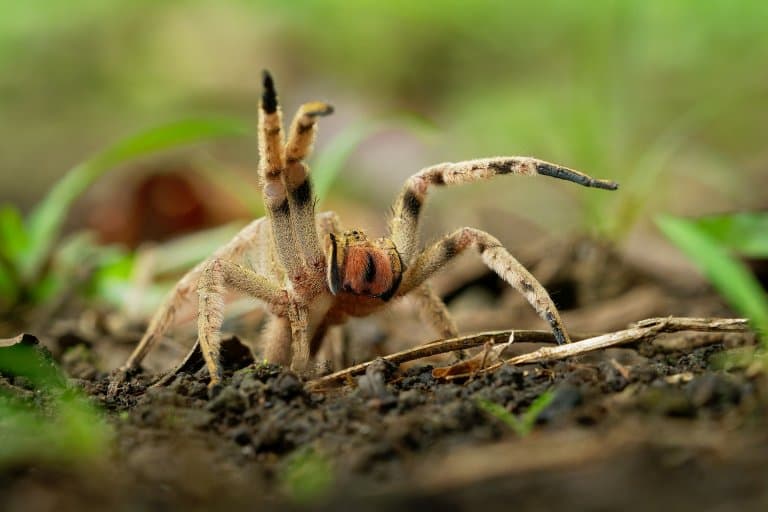
Brazilian Wandering Spider Facts Overview
These spiders are called wandering spiders because of instead of spinning a web to wait for food, or occupying a lair, they spend their night wandering in the leaf litter of the jungle floor for prey.
The sensitive hairs on its body help detect vibrations of passing prey, and it will feed on insects, lizards, frogs and any animals as large as itself.
During the day they will hide under logs, rocks, or inside termite mounds and banana plants. They will also sometimes wander into urban areas and homes, where they can come into contact with humans.
Brazilian wandering spiders are aggressive , dangerous and frightening. For once, this is an animal you should be wary of.
The females are larger, around 50% heavier than males, and produce more venom, and this might be a clue as to why their Greek name translates to “ Mudress” . These spiders will often stand and fight and have an intimidating threat display.
The potency of their venom is one of the reasons they’re so dangerous, and their ability to hide away in fruit and shoes explains why most bites are on extremities.
Interesting Brazilian Wandering Spider Facts
1. armed spiders.
In Brazilian, these are sometimes known as armed spiders, on account of their elongated front legs.
They can convey quite a bit of information with these legs, and as wandering spiders, use them to get about the forest, looking for food.
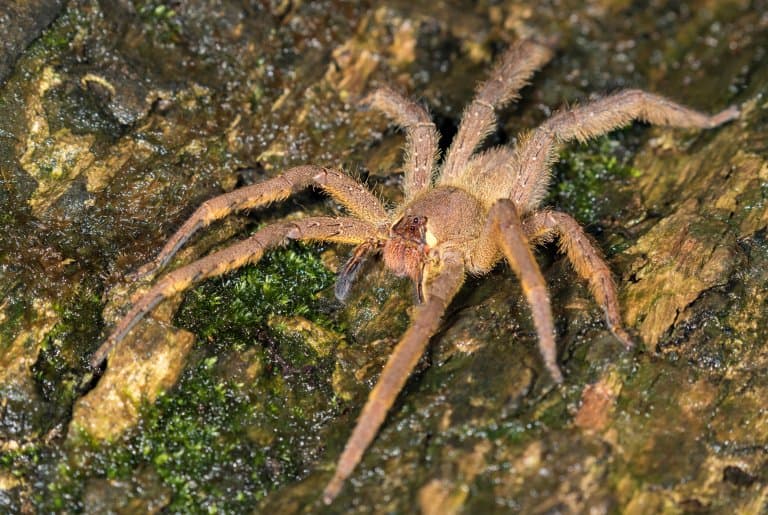
2. Banana Spiders
They’re also sometimes called ‘banana spiders’ on account of their status as a stowaway on popular fruit imported from the tropics.
This is becoming less common as stricter regulations ensure there’s less contamination of fruits, but there’s always a chance your next bunch of bananas will have a family of these spiders living inside it.
3. They have the largest venom glands of any spider
Females produce more venom than males, but both sexes have enormous venom glands. These glands are even more impressive when you consider the size of the spider is significantly less than the largest around.
The venom glands of the Brazilian Wandering Spider are over a centimetre long, and this is all housed inside the bright red chelicerae (mouth parts) which they are quick to display whenever they get upset. 1
4. They’re aggressive
These spiders can grow quite large and have long, brightly-coloured legs. Unlike most spiders, they’re known to stand their ground when threatened and are far quicker to bite than many other species.
They’ll still try to scurry away where possible, and they’re not out to get anybody.
But where most other species will flee, the wandering spiders’ aggression does make it more likely to be involved in incidents.
Most bites are on fingers and toes, a sign that they’re being stepped on or grabbed inadvertently. When the spider feels cornered, it’ll rear up on its back legs and waves its colourful arms around as a warning.
Then it’ll sway side to side, beckoning you to have a go. Anything foolhardy enough to call this bluff gets a wealth of envenomation effects. 2 3
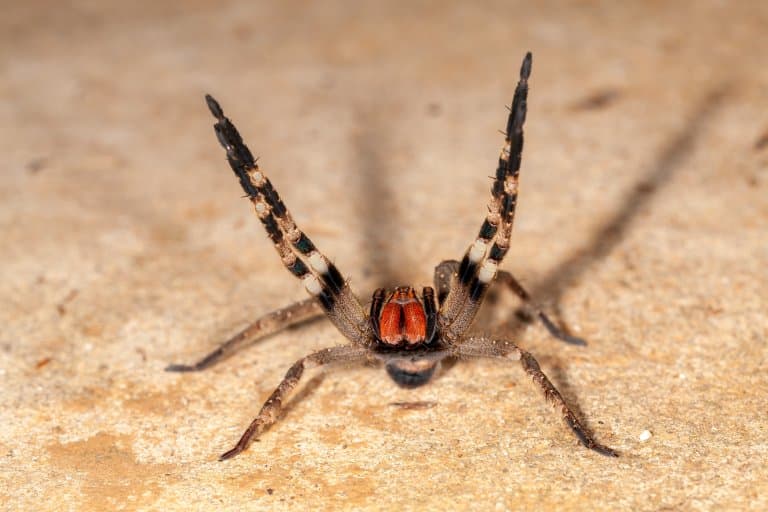
5. They give some men erections
There are ways to accomplish this with fewer side effects, but a bit from a Brazilian wandering spider does come with a certain Viagral quality.
This isn’t as fun as it might sound. Prolonged erections in this manner are likely to harm and destroy muscles and blood vessels in the penis and could cause irreparable damage.
Besides this, the assault on the central nervous system that comes with envenomation by this spider doesn’t sound worth it. 4
6. And some people die
This assault brings with it a whole host of unpleasant symptoms. Seizures, foaming at the mouth, inability to speak, collapse, and a host of other miserable experiences.
Paralysis is possible, as is cardiac shock. Blood vessels can burst in the brain, or anywhere else, and in many cases, this can be enough to kill a person.
This spider has one of the most potent venoms of all, and there are multiple legitimate records of death as a result of bites.
7. But they’re rarely fatal
While the Brazilian wandering spider is potentially one of the most dangerous spiders in the world, there is some evidence to suggest it gives a dry bite, defensively.
This means that despite exceptionally toxic venom, the amount actually injected is less than some of the other contenders, and this is what makes it typically less lethal than the Australian funnel webs.
These spiders are classified as Dangerous Wild Animals and would therefore require a special permit to keep. Bites from wandering spiders are common in South America, but antivenom is often readily available, and they rarely result in death.
In most cases, lethal bites are cases of a very young or very old victim, and few people of healthy age are killed. 5
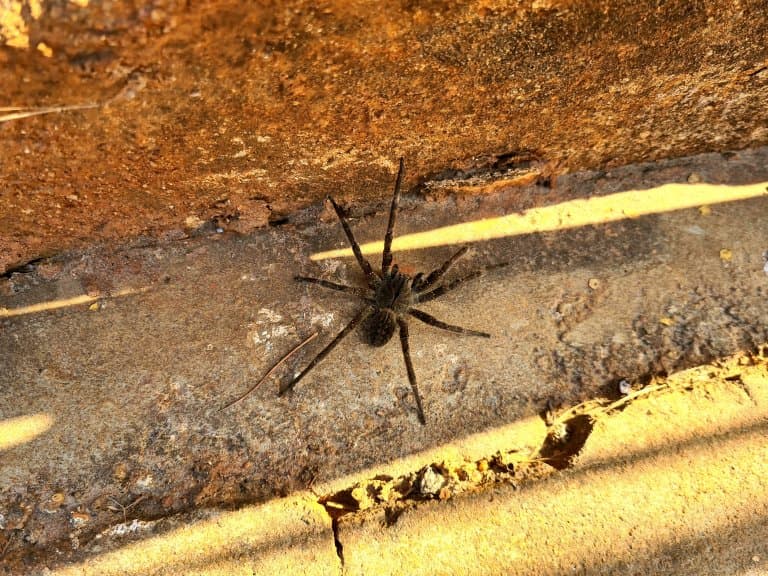
8. They do invade the UK sometimes
These unquestionably scary spiders show up in supermarkets in the UK on occasion, having hitched a ride on banana shipments.
On more than one occasion they’ve made their way into shoppers’ homes, but it doesn’t appear that there are any cases of them biting people as a result.
These spiders aren’t suited for temperate climates and don’t survive Winter, so there’s no risk of them multiplying.
Brazilian Wandering Spider Fact-File Summary
Scientific classification, fact sources & references.
- PeerJ. (2017), “ Dimensions of venom gland of largest venom glands in all spiders ”, Bio Numbers.
- Dave Clarke (2010), “ Venomous spider found in Waitrose shopping ‘beautiful but aggressive’” , The Guardian.
- “ Phoneutria Perty (Arachnida: Araneae: Ctenidae) ”, UF-IFAS University of Florida
- Kátia R.M. Leite (2012), “ Phoneutria nigriventer spider toxin Tx2-6 causes priapism and death: A histopathological investigation in mice ”, Science Direct.
- “ Brazilian wandering spiders: Bites & other facts ”, Live Science.

A home for Tarantula, Spider, Scorpion and Arachnid Enthusiasts.
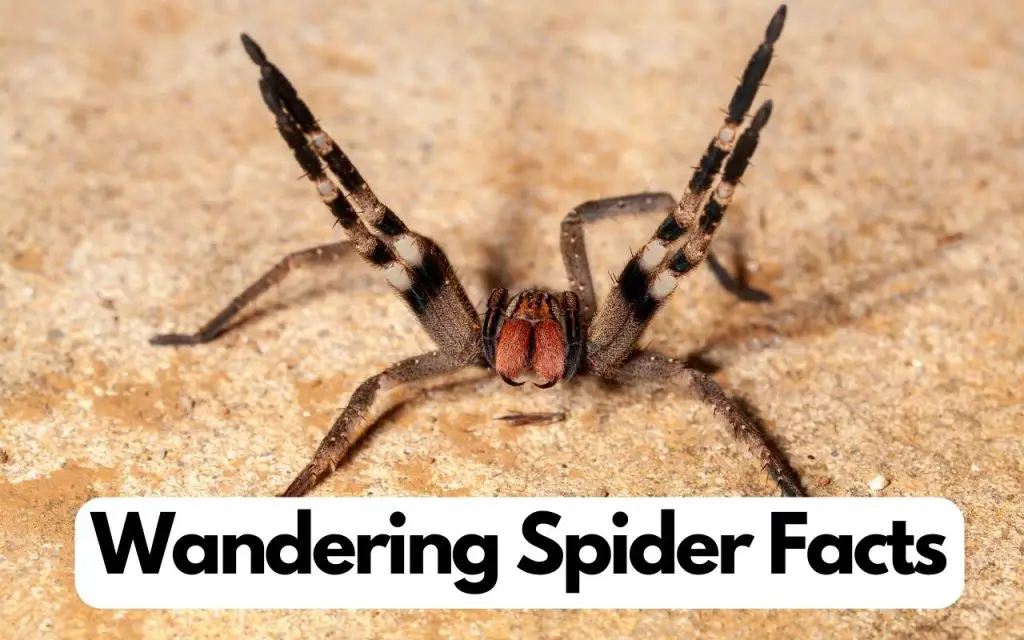
Brazilian Wandering Spider facts
Last updated on July 12th, 2023 at 01:48 pm
When you think of deadly spiders, there are a few names that spring to mind – but none more infamous than the Brazilian Wandering Spider. This species is reputed to have the most toxic venom of any spider, having a bite which causes horrendous side-effects like priapism and convulsions.
What you may not know, however, is that the Brazilian Wandering Spider name is actually used for a few species. The most common, and perhaps the most medically significant in the group are Phoneutria nigriventer and Phoneutria fera .
In this post, I’ll tell you more about these two species, from where they live, to what they eat. To keep things simple, I’ll just refer to them both as the “Brazilian Wandering Spider”, given how similar they are. Let’s dive in…
Quick Facts
To kick things off, here are some fascinating factoids about the Brazilian Wandering Spider:
- They belong to the genus ‘Phoneutria’, which translates to ‘murderess’ in Greek.
- They are known for their highly potent venom.
- Wandering Spiders are nocturnal creatures.
- They are also known as ‘banana spiders’ due to their tendency to hide in banana plants.
- They are not web-weavers but active hunters. This is called ‘cursorial’ hunting.
- It’s considered one of the most dangerous spiders in the world.
Other Common Names
The Brazilian Wandering Spider goes by several other names. The most common is the ‘banana spider’, thanks to their notorious habit of stowing away in banana shipments. In their native Portuguese, they’re known as ‘aranhas-armadeiras’ , translating to ‘armed spiders’ – a reference to their aggressive defense posture.
Brazilian Wandering Spider Venom
Possessing one of the most potent venoms among spiders, the Brazilian Wandering Spider’s bite is a cause for concern. Its venom is a complex cocktail of toxins, proteins, and peptides.
The main component that gets everyone’s attention is the neurotoxin, called PhTx3 , which can interfere with the functioning of our nervous system, leading to a variety of symptoms.
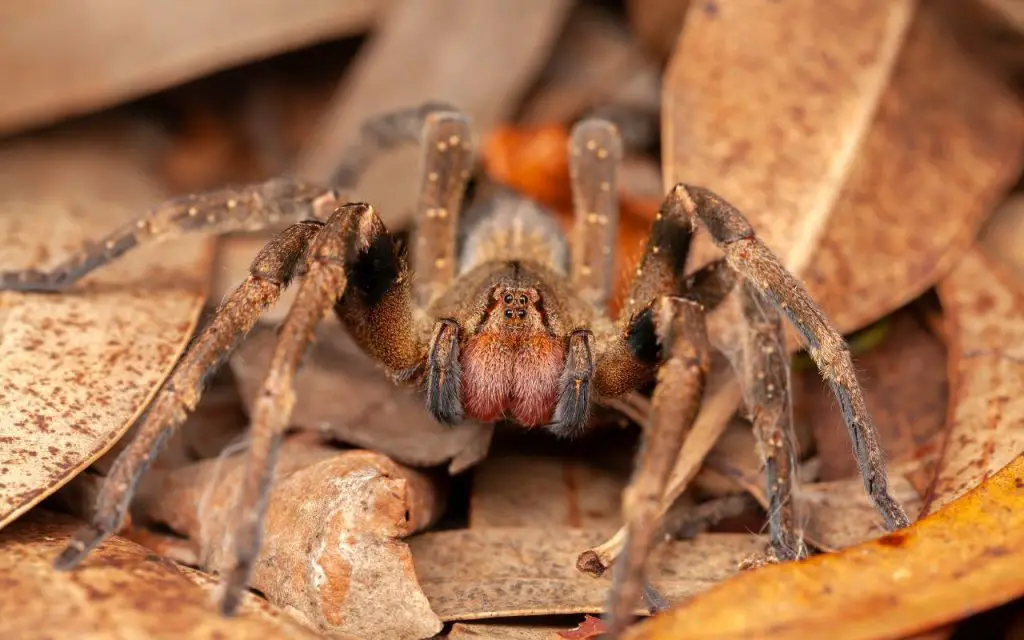
What’s the Benefit of Having Such Strong Venom?
With venom potent enough to kill a human, one might wonder why this spider needs such a powerful weapon. The answer lies in its lifestyle.
Brazilian Wandering Spiders are active hunters and their venom is primarily used to incapacitate prey quickly. The venom’s potency also serves as an effective deterrent against potential predators.
Brazilian Wandering Spider Deaths
Despite the notorious reputation, actual deaths from Brazilian Wandering Spider bites are rare. This is largely due to the rapid medical attention available in areas where these spiders are common. Plus, these spiders don’t always inject venom when they bite – a dry bite can occur.
This actually common in venomous animals, including spiders and reptiles. Occasionally they bite and decide to not inject any venom. The point of this is to conserve it, given that it is energetically costly to produce.
Brazilian Wandering Spider Size
Being quite large and impressive compared to most arachnids, adult Brazilian Wandering Spiders can reach a leg span of up to 7 inches (18 cm) . The body size excluding the legs can be up to 2 inches (5 cm). Their size contributes to their intimidating presence.
If you’d to learn more about why they get so big, check out my article on Brazilian Wandering Spider size for more info!
Brazilian Wandering Spider Location and Habitat
Brazilian Wandering Spiders are native to South America. Here’s a quick rundown of their range and preferred habitats:
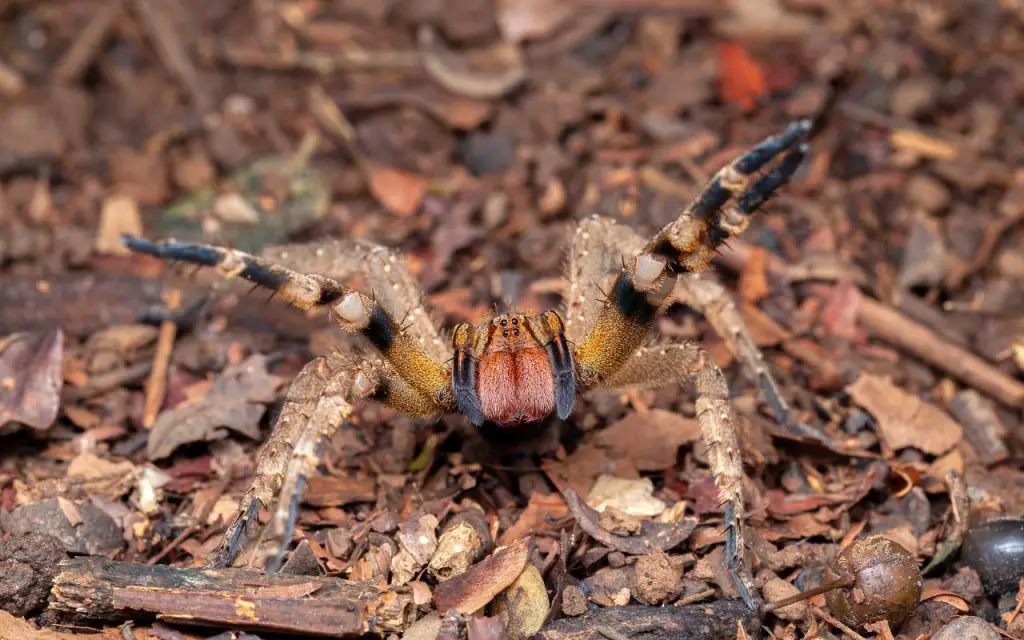
Brazilian Wandering Spider Speed
An adept hunter, the Brazilian Wandering Spider can move quickly when chasing prey or evading threats. While exact speed measurements can vary, some sources report that these spiders can achieve speeds up to 1 meter per second.
What Does the Brazilian Wandering Spider Eat?
The Brazilian Wandering Spider’s diet consists mainly of insects, other spiders, and occasionally small amphibians and reptiles. Their potent venom allows them to tackle prey larger than themselves, making them one of the apex micro-predators in their habitat.
Final Thoughts…
While the Brazilian Wandering Spider might seem terrifying to many, as an arachnid enthusiast, I find them to be incredibly fascinating. Their potent venom, hunting prowess, and adaptation to diverse habitats reveal the intricate beauty of the evolutionary process.
Just remember, these spiders, like all creatures, play a vital role in our ecosystem. Respect, not fear, should be our response to these remarkable arachnids.
The truth is that most bites are accidental, but they do occur. The fact that so few deaths occur each year is a testament to the effectiveness of the antivenom that has now become widely available.
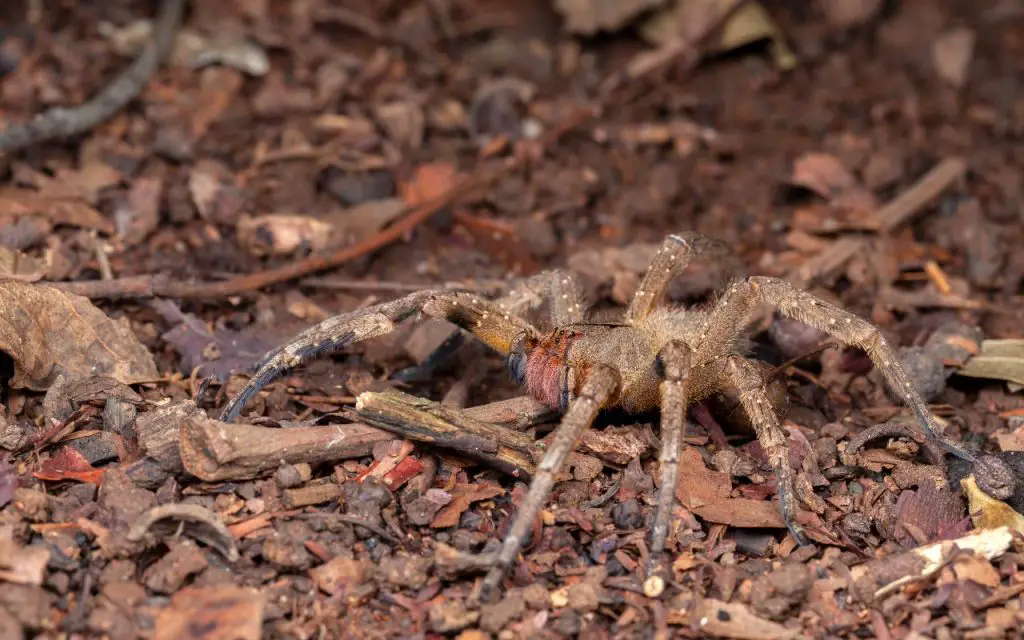
FAQ related to the Brazilian Wandering Spider
What happens if you are bitten by a brazilian wandering spider.
Immediately after a bite from a Brazilian Wandering Spider, you will experience localized pain. Then, within 5 to 15 minutes the area around the bite will swell. The swelling can spread to most of a limb, for example. Finally, neurological symptoms like coldness, sweating, and convulsions will set in.
Do wandering spiders jump?
Wandering Spiders are excellent at jumping. They can jump several feet when surprised, and may occasionally use this as a tactic to evade predators. Jumping at you isn’t part of how bites happen though. When faced with humans, Wandering Spiders usually stand their ground and use their threat display of raised legs to warn us away.
Is Brazilian wandering spider friendly?
Wandering Spiders are not friendly. As a general rule, they are relatively calm, but can also be defensive. They tend to see humans as a threat, and will not take to being handled easily. That said, they are not aggressive, and most bites happen when someone accidentally touches one or tries to kill it.
Are Brazilian wandering spiders in Australia?
Brazilian Wandering Spiders are not found in Australia. The only species in Australia that get as large as Wandering Spiders are the Huntsman Spiders. At a distance they may appear relatively similar, but Huntsman Spiders are completely harmless to humans.
Related Posts:
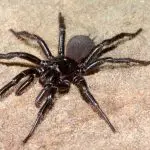
Leave a Comment Cancel Reply
Your email address will not be published. Required fields are marked *
Save my name, email, and website in this browser for the next time I comment.


Brazilian wandering spider | bite,Size, Habitat, & Facts
Brazilian wandering spider.
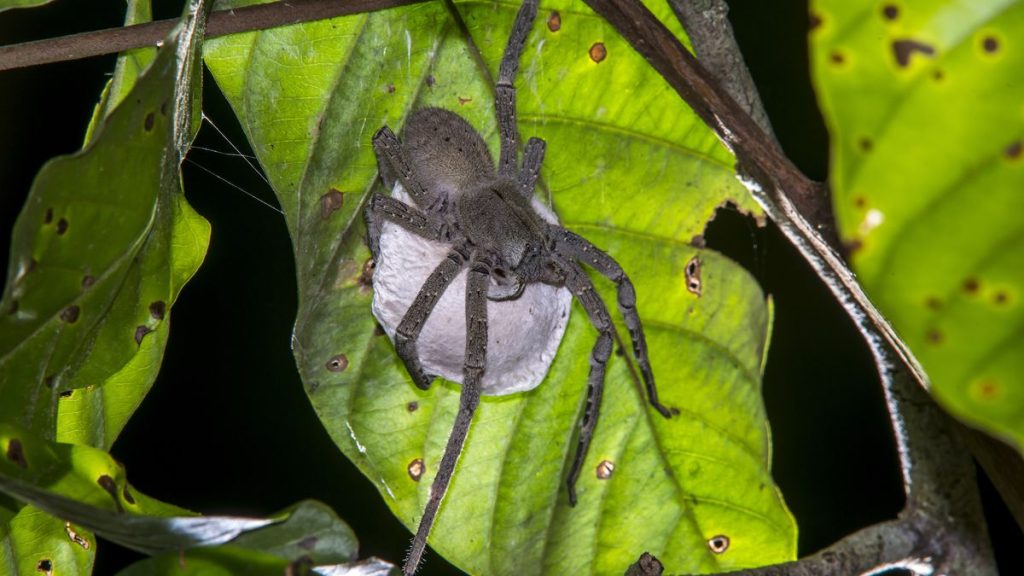
brazilian wandering spider size
Their body length ranges from 17 to 48 mm (43⁄64 to 1+57⁄64 in). Phoneutria are impressive spiders reaching body sizes up to 3.5 centimeters and leg spans up to 15 centimeters. They are nocturnal, hunting at night, and hiding in dark places during the day.
Wandering spider bite
Along with other members of the genus, they are often referred to as Brazilian wandering spiders. Its bite can cause severe symptoms, including increased pulse, blood pressure, and respiratory rate; extraordinary pain; penile erection that lasts for several hours; and, in several documented cases, death.
Phoneutria spp. is actually a genus with five known similar species whose members are highly venomous. They include some of the relatively few species of spiders that present a threat to human beings. The Brazilian Wandering Spider (Phoneutria fera) can grow to have a leg span of up to 4-5 inches.
Wandering spider, (family Ctenidae), any member of the family Ctenidae (order Araneida), a small group of large spiders of mainly tropical and subtropical regions, commonly found on foliage and on the ground.
The Brazilian wandering spiders, Phoneutria fera and P. nigriventer, are sometimes also referred to as banana spiders because they are frequently found on banana leaves. They have an aggressive defense posture, in which they raise their front legs straight up into the air. Phoneutria are venomous, and their venom is toxic to the nervous system, causing symptoms such as salivation, irregular heartbeat, and prolonged painful erections (priapism) in men. Scientists are investigating the venom of P. nigriventer as a possible treatment for erectile dysfunction.
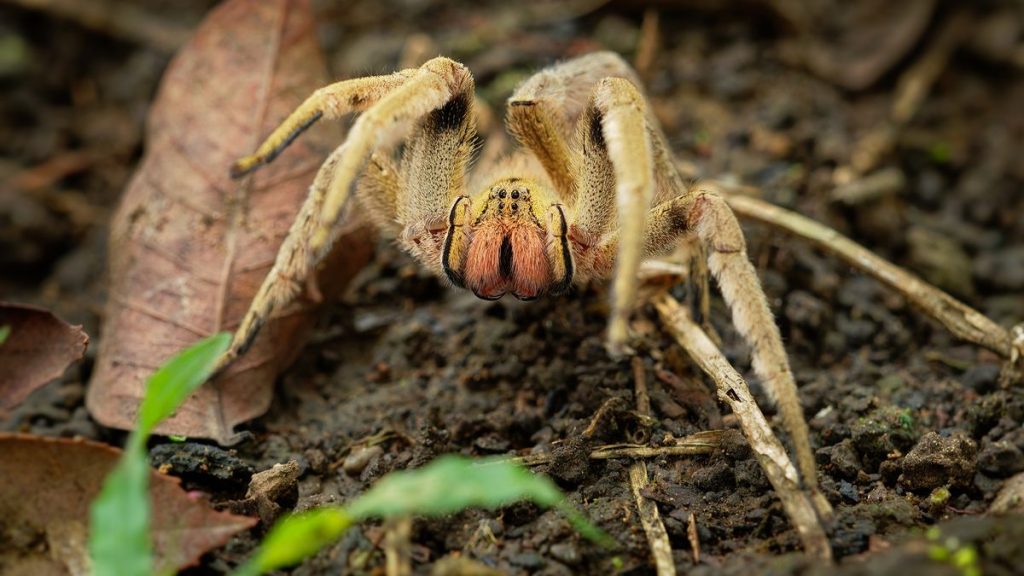
These spiders are notorious both due to their toxic venom, and because they are not reluctant to attack people who appear threatening.
Of the five species known, P. nigriventer and P. fera most frequently receive mention in mass-media publications. P.nigriventer species are responsible for most cases of venom intoxication in Brazil because this species is commonly found in highly populated areas of Brazil, namely the South-eastern states: São Paulo, Minas Gerais, Rio de Janeiro and Espírito Santo.The P. fera is native to the northern portion of South America, especially the Brazilian Amazônia, Venezuela and French Guiana.
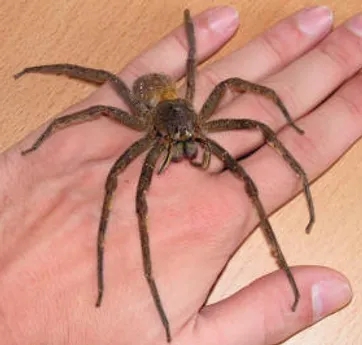
Brazilian wandering spider BITES AND VENOMB
razilian wandering spiders’ venom is a complex cocktail of toxins, proteins and peptides, according to the Natural History Museum in Karlsruhe, Germany. The venom affects ion channels and chemical receptors in victims’ neuromuscular systems.
After a human is bitten by one of these spiders, he or she may experience initial symptoms such as severe burning pain at the site of the bite, sweating and goosebumps, Sewlal said. Within 30 minutes, symptoms become systemic and include high or low blood pressure, fast or a slow heart rate, nausea, abdominal cramping, hypothermia, vertigo, blurred vision, convulsions and excessive sweating associated with shock. People who are bitten by a Brazilian wandering spider should seek medical attention immediately.
Recent studies suggest that these spiders only inject venom in approximately one-third of their bites and may only inject a small amount in another third. However, research in this area is hindered by the difficulty of identifying particular subspecies. Thus the effects of the bites from these spiders are hard to predict when based on sketchy information or if the spider has not been identified definitively.
Bites from these spiders may result in only a couple of painful pinpricks to full-blown envenomation. In either case, people bitten by a Phoneutria or any Ctenid should seek immediate emergency treatment as the venom is possibly life threatening.
he Phoneutria fera and nigriventer are the two most commonly implicated as the most virulent of the Phoneutria spiders. The Phoneutria not only has a potent neurotoxin, but is reported to have one of the most excruciatingly painful envenomations of all spiders due to its high concentration of serotonin.
Brazilian Wandering Spiders are extremely fast, extremely venomous, and extremely aggressive and are ranked among the most venomous spiders known to man. In fact, the Brazilian Wandering Spider is the most venomous spider in the New World! In South America, these true spiders are commonly encountered in peoples’ homes, supposedly hiding in peoples’ shoes, hats, and other clothes. It does not remain on a web, rather, it wanders the forest floor, which is how it got its name.
The Brazilian Wandering Spider has another name – the Banana Spider and it was given this name because there have been cases where these spiders unintentionally appeared on banana boats heading for the United States.
Brazilian Wandering Spider: One Of The World’s Most Venomous Spiders May Be Lurking In Your Bananas
Meet the Brazilian wandering spiders in the genus Phoneutria, also referred to as the armed spiders or the banana spiders. The members of this group have one of the most dangerous bites of any spider species on Earth and they have been classified as the world’s most venomous spider many times.
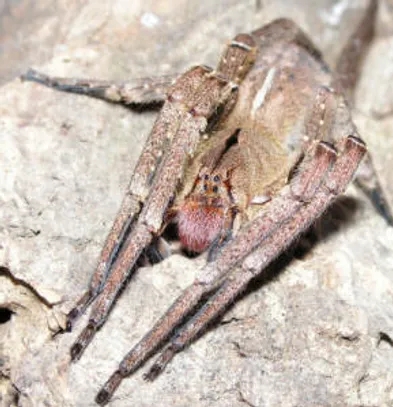
What Are The Effects Of A Brazilian Wandering Spider Bite?
Brazilian wandering spiders often make the news because of the unusual symptoms caused to humans after being bitten by one.
A 2023 study in Frontiers In Molecular Biosciences suggested there were around 4,000 cases of people being bitten by Phoneutria nigriventer in Brazil each year. Their venom affects the nervous system, causing double vision, salvation, irregular heartbeat – and even prolonged painful erections, known as priapism. In fact, because of this, their venom is being explored as a possible treatment for erectile dysfunction conditions.
Can A Brazilian Wandering Spider Bite Kill You?
The neurotoxin PhTx3 is to blame for these symptoms, and according to the Independent, a wandering spider bite can reportedly be fatal in as little as 60 minutes. However, an effective anti-venom is usually enough to save those affected. A study into Phoneutria boliviensis in 2019 suggested that the species had adapted its venom to catch vertebrates as opposed to lizards and amphibians, which might explain why the venom is so toxic to humans.
black and yellow garden spider
Brown recluse spider bite stages pictures.
UK Edition Change
- UK Politics
- News Videos
- Paris 2024 Olympics
- Rugby Union
- Sport Videos
- John Rentoul
- Mary Dejevsky
- Andrew Grice
- Sean O’Grady
- Photography
- Theatre & Dance
- Culture Videos
- Fitness & Wellbeing
- Food & Drink
- Health & Families
- Royal Family
- Electric Vehicles
- Car Insurance Deals
- Lifestyle Videos
- UK Hotel Reviews
- News & Advice
- Simon Calder
- Australia & New Zealand
- South America
- C. America & Caribbean
- Middle East
- Politics Explained
- News Analysis
- Today’s Edition
- Home & Garden
- Broadband deals
- Fashion & Beauty
- Travel & Outdoors
- Sports & Fitness
- Sustainable Living
- Climate Videos
- Solar Panels
- Behind The Headlines
- On The Ground
- Decomplicated
- You Ask The Questions
- Binge Watch
- Travel Smart
- Watch on your TV
- Crosswords & Puzzles
- Most Commented
- Newsletters
- Ask Me Anything
- Virtual Events
- Betting Sites
- Online Casinos
- Wine Offers
Thank you for registering
Please refresh the page or navigate to another page on the site to be automatically logged in Please refresh your browser to be logged in
Brazilian wandering spider: Where are they from and how deadly are they?
One was found in a bunch of supermarket bananas in london, article bookmarked.
Find your bookmarks in your Independent Premium section, under my profile

Sign up to the Independent Climate email for the latest advice on saving the planet
Get our free climate email, thanks for signing up to the independent climate email.
The world’s most venomous spider has been delivered to a south London home in a bunch of bananas.
Specialists were called in to trap the Brazilian wandering spider, which ripped its leg off in a bid to escape and left an egg sac full of thousands of baby spiders behind.
The family who received the deadly arachnid in their Waitrose online shop told the Mail on Sunday they were “too traumatised to remain in the house”, while the supermarket apologised for the “distressing” incident.
It was not the first time a Brazilian wandering spider made the long journey to the UK.
In 2005, a chef in Somerset was bitten by a stowaway that had been hiding in bananas delivered to his pub.
He was saved by anti-venom administered after a nearby zoo identified the arachnid from a picture he took on his phone before passing out.
The spiders and their eggs have also been found in bananas from a Tesco in Essex and One Stop in Staffordshire.
Where are they from?
Fortunately, it is very rare to find Brazilian wandering spiders in the UK or anywhere outside their natural habitat in South America.
They live in the forests of Costa Rica, Columbia, Peru, Brazil, and Paraguay and gain their name from the habit of moving across jungle floors at night in search of food.
In the day, they like hiding in places that are dark and moist and are known to favour piles of wood, garages, cupboards, shoes and even heaps of clothes.
The apparent tendency to hide in banana bunches – like in the latest incident – has given them the nickname “banana spider”.
Their scientific name translates as “murderess” in Greek and they are also known as the “armed spider”, because of their unusual attacking stance, and “horse stinger”.
How deadly is it?
The Guinness Book of World Records has named it the most venomous spider in the world for possessing the most active neurotoxic venom of any living spider.
The toxin PhTx3 causes extreme pain, swelling, paralysis, skin cell destruction, fatal breathing complications, heart attacks and painful erections (priapism) in men lasting up to four-hours.
Victims of a Brazilian wandering spider bite can reportedly be killed in an hour.
But few deaths occur because an effective anti-venom is available in Brazil and Guinness claims that people are killed, it is usually in children under the age of seven.
Scientists have reportedly considered investigating the use of the deadly venom as a possible ingredient for drugs treating erectile dysfunction.
What do Brazilian wandering spiders look like?
There are eight known species, with the most dangerous being the Phoneutria fera and the Phoneutria nigriventer.
All vary slightly in appearance but are known for their size, with a leg span of up to 15 cm (6 ins) and body length of up to 5 cm (2 ins).
They are covered with hair and usually dark brown in colour, with some displaying bright red hairs on their venom glands.
When Brazilian wandering spiders feel threatened, they adopt a distinctive “attacking” stance with their front legs in the air, swaying from side to side.
How do they attack?
The spiders use bites as their main form of attack but do not always deliver venom, using it only in an estimated third of bites.
They eat insects and small mammals, including other spiders, amphibians, reptiles and mice, hunting them on the ground and killing with an ambush or direct attack.

Join our commenting forum
Join thought-provoking conversations, follow other Independent readers and see their replies
Subscribe to Independent Premium to bookmark this article
Want to bookmark your favourite articles and stories to read or reference later? Start your Independent Premium subscription today.
New to The Independent?
Or if you would prefer:
Want an ad-free experience?
Hi {{indy.fullName}}
- My Independent Premium
- Account details
- Help centre
The world's deadliest spider? The answer is poisonous (and unexpected.)

Afraid of spiders? Your aversion might actually be wise. Though the many-legged arachnids are a great deal smaller than we are, some can be extremely dangerous with bites that could end a human life.
No need to fear too much if you walk through a web though, not all spiders are so threatening. And, even for the ones that are, advances in anti-venom technology have made treatment more effective.
Understanding the true danger of certain spiders requires a few myths to be busted first. Here’s everything you need to know about which arachnids to avoid from daddy long legs to tarantulas to black widows.
What is the deadliest spider in the world?
The funnel web spider is widely regarded as the most dangerous arachnid. This Australian spider has a venom that is packed with 40 different toxic proteins.
Though a bite from one of these creatures is certainly capable of killing a human, no deaths have been reported from a funnel web spider in Australia since 1980 .
Are daddy long legs poisonous?
Not in any dangerous way. But wait, aren’t daddy long legs the most dangerous spider in the world? No, this is a myth . While it is true that daddy long legs are venomous, all this means is they anatomically have specific glands used for the production of venom.
“Daddy long legs” is actually an umbrella term that is used to refer to three different groups: pholcid house spiders, crane flies (which are not arachnids at all), and harvestmen. The last two have no venom at all while the first does carry venom but not any that is especially dangerous or has been reported to cause a reaction in humans. This form of “daddy long legs” does have fangs and can therefore likely bite you, but there is no evidence showing it will be harmful.
What are the deadliest spiders?
There is some debate around this topic. But, according to CBS News , ten of the deadliest spiders include:
- Sydney funnel-web spider
- Redback spider
- Chilean recluse spider
- Brazilian wandering spider
- Sicarius spiders
- Brown recluse spiders
- Black widow spiders
- Hairy mystery spiders
- Brown widow spiders
- Katipo spiders
Encyclopedia Britannica adds Yellow Sac spiders, Red Widow spiders, and Wolf spiders to that list.
Can a black widow kill you?
Rarely . A black widow bite only poses a high health risk for young children and the elderly, especially given advancements in anti-venom medical technology.
Black widows are indeed the most venomous spider in North America though (Australian spiders have a special claim to fame). Their venom has a chemical called alpha-latrotoxin which causes intense pain, cramping, swelling, sweating and chills.
If you visit a doctor, they might give you antivenom to treat the bite which will neutralize the venom and relieve some of the pain.
Are banana spiders poisonous?
Banana spider are not poisonous and are generally not considered a grave danger to humans, though their bite can be painful .
There is one type of banana spider known as the Brazilian wandering spider which can, in rare cases, cause intense symptoms. This is not a spider usually found in the U.S.
Are wolf spiders poisonous?
Wolf spiders, like banana spiders are venomous but not poisonous . Their bites are not known to cause serious harm to humans.
People can have allergic reactions to the venom , but this is not common.

Are tarantulas poisonous?
Tarantulas do not pose a major health risk . Their venom has very low toxicity to humans. So, despite their unsettling appearance, there’s very little reason to fear these furry creatures.
Just curious for more? We've got you covered
USA TODAY is exploring the questions you and others ask every day. From "How to get rid of gnats? " to " How many Spiderman movies are there? " to " How to cancel Apple Music? ", we're striving to find answers to the most common questions you ask every day. Head to our Just Curious section to see what else we can answer for you.
Search Collections Databases
Myth: deadly australian/brazilian spiders, myth: but there are really deadly spiders in australia and brazil..
Fact: The previous myth page, where I said that no spider species anywhere can properly be called "deadly," generated more comments than any other on the site. Most were from Australians who were certain their country at least had truly deadly spiders, including the Sydney Funnelweb Spider, Atrax robustus, and the Redback Spider, Latrodectus hasselti . Some also mentioned White-tailed Spiders, genus Lampona . Some comments were from Brazilians who put forward their Phoneutria wandering spiders as the world's deadliest.
To start with, these people had misunderstood what I said. I never claimed that no human ever died from spider venom. What I said was, there is no species whose bite kills much more than 5% of its victims, nor any spider that kills within minutes, like in the movies. This applies just as strongly to Australia and Brazil as to the USA.
According to the Australian Museum, the number of human deaths from authentic spider bites of any kind in Australia since 1979 has been zero. A recent published medical study followed 750 genuine Australian spider bite cases with identified spiders over 27 months (1999-2001). Only 44 bites (6%, mostly redback spider bites) had significant effects. Only 6 redback bites and 1 Atrax bite were serious enough to need antivenom. In no case was there any sign of allergic response to spider venom, and I have only seen one such case in North America in 44 years.
Atrax robustus , the Sydney Funnelweb Spider, is often publicized as the "world's deadliest." Authentic medical information suggests otherwise. There have been no deaths (out of 30-40 bites per year) since antivenom was introduced in 1980. During the 53 year period 1927-1979 there were 13 or 14 known deaths, which would be a death rate of under one percent! Although one child died in 15 minutes, adult fatalities typically took 2-3 days. 90% of Atrax bites are judged not serious enough to need antivenom.
Most serious spider bites in Australia are from the Redback, Latrodectus hasselti , a close relative of American black widows with very similar venom and effects. The recent study mentioned above tallied 56 genuine redback bites. Only 37 (66%) had any serious effects, and only 6 (11%) were serious enough to need antivenom. There have been no redback-caused human deaths in several decades.
White-tailed spiders, Lampona cylindrata and relatives, have recently been blamed for Australian cases of severe necrotic lesions, but this connection was not based on enough evidence. The same authors who did the 750-bite study mentioned above, gathered a further 130 cases (aged 3-76 years) bitten by identified Lampona spiders. Local pain and itching were the only effects. No one developed any lesion or ulcer. White-tailed spiders are not guilty of doing any serious harm to humans; this page has more details.
Brazilian Wandering Spiders ( aranhas armadeiras ), Phoneutria nigriventer , P. keyserlingi and P. fera , are sometimes said to have the world's most toxic spider venom – probably based on a well publicized study where mice were killed by intravenous injection of as little as 0.006 mg of venom. Since I'm a man, not a mouse, that doesn't worry me much. Authoritative sources state that over 7,000 authentic cases of human bites from these spiders have been recorded, with only around 10 known deaths, and about 2% of cases serious enough to need antivenom. So despite the surprisingly large number of bites, this spider is not exactly public enemy number one either.
Most medical conditions blamed on spiders by physicians lack confirmation that any actual spider was involved in the case. Spider bites of all kinds are rare events (as opposed to other bites and medical conditions that get wrongly blamed on spiders). Although it is possible for a spider bite to cause death, that is a very unlikely outcome and does not happen in enough cases to justify calling any spider "deadly."
Spider Myths
"Everything that 'everybody knows' about spiders is wrong!" — Rod Crawford sets the record straight with Spider Myths .
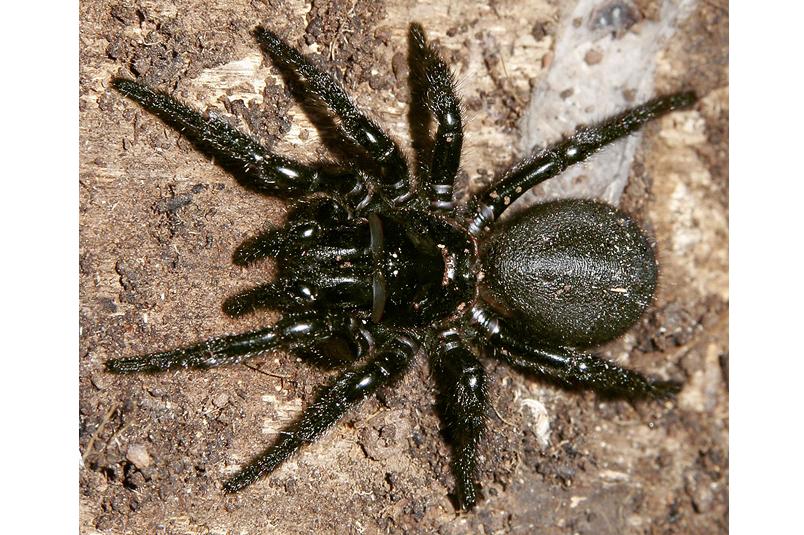
Female Sydney Funnelweb Spider, Atrax robustus . Human deaths from bite are rare. Photo: Fir0002 from Wikimedia Commons, under GNU Free Documentation License
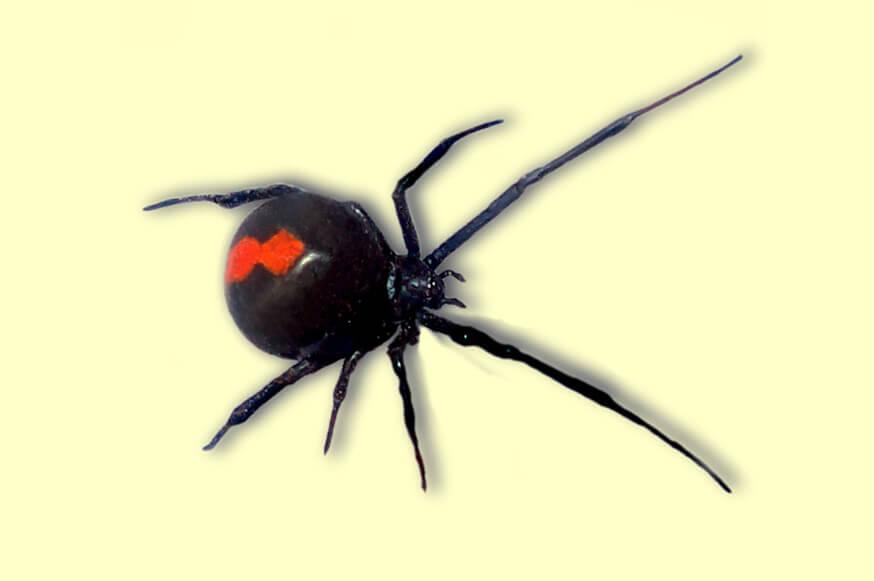
Female White-Tailed Spider, Lampona sp . Now proven 100% harmless! Photo: David McClenaghan, CSIRO from Wikimedia Commons
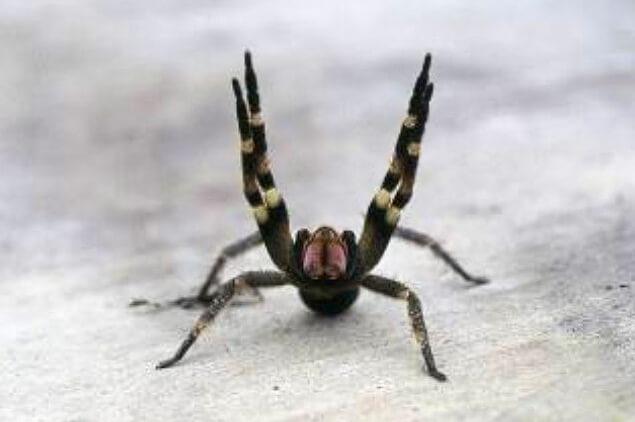
Female Brazilian Wandering Spider, Phoneutria nigriventer . Human deaths from bite are rare. Photo: Paraná State Govt., Brazil
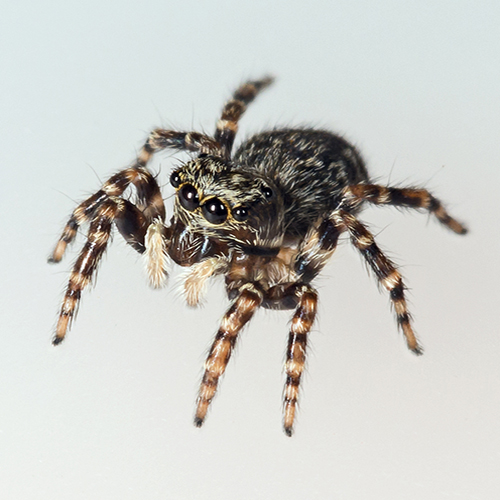
Spider Myth Resources
Explore even more! Additional spider resources and more myths (poor spiders can't catch a break!).

Become a member
Experience even more. A membership pays for itself in 3 visits!
Just want tickets?
Continue to general admission tickets page.
Buy tickets
Looking for a special event?
View calendar
Spider Research
Department of Entomology
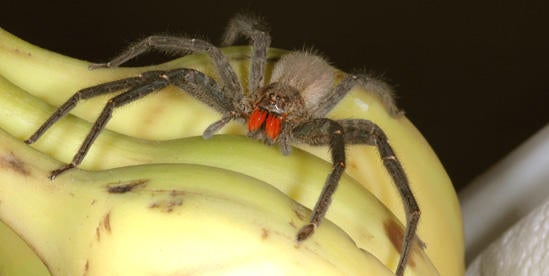
Deadly Banana Spiders !!!!!!!!! Or not
Updated 3 aug 2015.
Every once in a while in North America, a large spider (or a spider egg sac) is found in international cargo, most commonly in bananas. The spider is collected and taken to a local “authority” who typically has no arachnological experience. A quick search of the Internet leads the “authority” to identify the spider as a deadly armed or wandering spider of Brazil (genus Phoneutria ) and then, panic and hyperbolic media coverage ensues. However, most of the time, these incidents are misidentifications of harmless spiders. This is due in part to the dynamic nature of being associated with a potential dangerous animal. People like to jump to the exciting conclusion that they are dealing with a “deadly” creature. Another contributor to the hyperbole is that a quick identification is understandably forced by a desire to know if the spider is indeed dangerous so that cargo crews will not suffer envenomations and cargo can then be unloaded before it decays (in the case of fruit). People then err on the side of the fantastic rather than caution.
Information regarding spiders collected from bananas can be found in the two articles below, which can be obtained from me in PDF form with an email request. [email protected]
Vetter, R.S. and S. Hillebrecht. 2008. On distinguishing two often-misidentified genera ( Cupiennius , Phoneutria ) (Araneae: Ctenidae) of large spiders found in Central and South American cargo shipments. American Entomologist 54: 82-87.
Vetter, R. S., R. L. Crawford and D. J. Buckle. 2014. Spiders (Araneae) found in bananas and other international cargo submitted to North American arachnologists for identification. Journal of Medical Entomology 51: 1136-1143.
Information on spider egg sacs found on bananas is also presented below but read through the information on the spiders first
Armed spiders (Genus Phoneutria )
Spiders of the genus Phoneutria cause the greatest concern. Typically, harmless spiders are misidentified as Phoneutria spiders when intercepted in cargo. The reason for this misidentification is the well-known fact that some species of Phoneutria have red hairs on their chelicerae (the two structures below the eyes on the “face” which have fangs at the end). Unfortunately, these are not the only large spiders found in bananas that have these red hairs. Because almost no one in North America has the proper identification publications for South American spiders, they turn to either the Internet (where the spiders are often already misidentified) or the Golden Guide to Spiders, a very rudimentary identification guide.
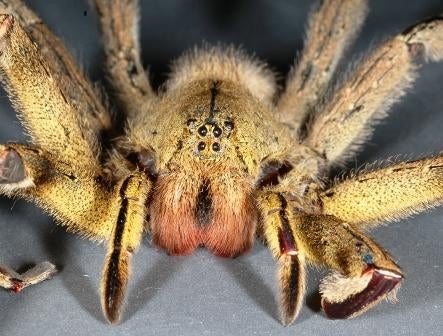
The dangers associated with these spiders for North Americans are very much overexaggerated. First, the most cited dangerous species is Phoneutria fera . This is actually an Amazonian species, (i.e., it lives in the Brazilian Amazon) far from areas of human commerce and the Brazilian banana plantations and, therefore, they don’t have the opportunity to be transported in cargo, or at least are highly unlikely to be so moved. In Germany from decades ago, specimens listed as imported P. fera were most likely misidentified specimens of other Phoneutria species. (One must also keep in mind that Phoneutria taxonomy has been a nightmare for the last century with new species being named and other names being absorbed by other existing species, back and forth almost like an Abbott and Costello comedy routine. It is really difficult sometimes to pin down a name because for some spider groups, the taxonomy is not yet settled). The spiders intercepted in Germany were most likely specimens of P. nigriventer and P. keyserlingi , which are only found on the Atlantic coast of Brazil and are mostly involved in Brazilian envenomations. All three of these spiders can get up to 50 mm in body length. However, they still are not nearly as deadly as people claim. In one study of 422 Phoneutria bites in coastal Brazil, only 2.3% of the victims required antivenom and the only death was one small child. Although there is an obvious major concern when children are bitten, most bite victims experienced minor problems without long-lasting effects and certainly not death. Most of the bites were in adults; minor symptoms resolved without complications.
Although these large spiders were transported in bananas to Europe many years ago, currently, Brazil consumes almost all of its banana crop domestically so now there is less chance for the spiders to be transported out of the country, at least in fruit.
On the west coast of South America, another species, P. boliviensis , exists and has occasionally been transported in cargo to North America (mostly from Ecuador). However, in comparison to its eastern relatives, this species is smaller (30 mm body length) and its envenomation effects are milder. A paper on bites in plantation workers revealed annoying symptoms but no deaths. Workers missed 2 to 3 days of work. So even if these spiders were transported to North America, they are not considered very dangerous and should not cause concern.
To summarize:
- The dangerous species of Phoneutria are found in the Amazon where interaction with people is rare and transport out of the country in commerce is highly unlikely.
- The two species associated with high human population on the eastern Brazilian coast cause human envenomations but are not as dangerous as they are reported to be. Although they can cause death in young children, most bite victims experience mild reactions.
- Brazil no longer exports much of their banana crop.
- The western South American species of Phoneutria is much smaller than the eastern species and although sometimes is transported, it is not a major medical concern when bites occur.
- All Phoneutria species are virtually restricted to South America. If a spider is found in a banana shipment from Central America, then it is highly unlikely to be a Phoneutria spider (see next section)
Cupiennius spiders
These are the spiders that are most frequently mistaken as Phoneutria spiders. They are large, found in banana shipments and one species, Cupiennius chiapanensis , has bright red hairs on its chelicerae. One major contributing factor to the confusion is that C. chiapanensis was only officially described in 2006 so only a few arachnologists in Central America were aware of this spider. There are other species, C. getazi , and C. coccineus, which have sometimes been transported to North America in bananas. The large species of Cupiennius, which are most frequently found in banana shipments in North America, live exclusively in Central America. They have characteristic coloration:
Cupiennius chiapanensis - bright red hairs on chelicerae
Cupiennius getazi - underside of legs near body has black dots on white background
Cupiennius coccineus - underside of front legs near body has bright red hairs
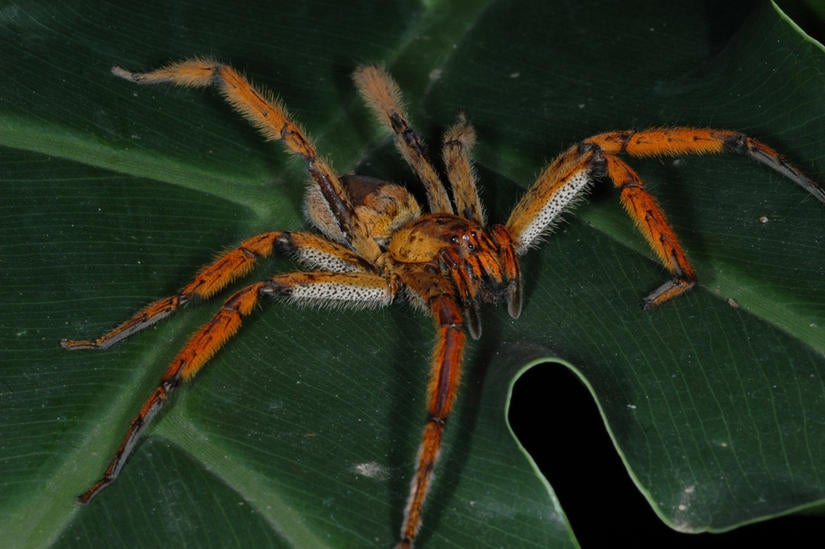
Cupiennius getazi
However, because C. chiapanensis has bright red hairs on the chelicerae and was only recently described, almost no sources have accurate information on this spider. Hence, it looks closest to Phoneutria fera and then the hysteria starts. I am aware of 6 cases where a North American arachnologist (including myself) as well as several Mexican authors made misidentifications, most of which came before 2006. No species of Cupiennius spider is considered dangerous and verified bites result in mild pain for a short time with no long-lasting effects.
- Cupiennius spiders are often found in banana shipments to North America but are harmless.
- Cupiennius spiders are virtually restricted to Central America or at least the ones that end up in banana shipments come only from Central America.
- Cupiennius chiapanensis has only been officially known since 2006 and is frequently mistaken as the potentially dangerous Phoneutria fera , even by experienced arachnologists because both spider species have red hairs on their chelicerae.
Huntsman spider, Heteropoda venatoria
This spider is established worldwide in tropical areas including Hawaii and Florida. It is frequently found in cargo shipments of all kinds and in bananas is common from Ecuador. It has a white “moustache” under its eyes and holds it legs rotated to the side like a crab. The males and females have strikingly different coloration. These spiders are harmless.
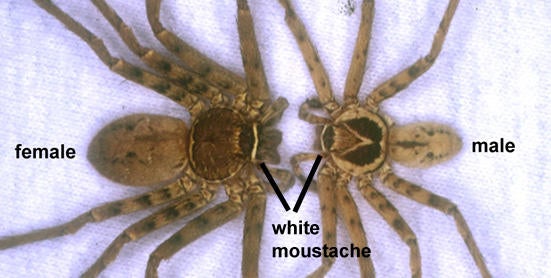
Summary for the entire page so far
- If you have a large spider found in bananas from a country in Central America, it is most probably going to be a harmless species of the genus Cupiennius .
- If you have a large spider found in bananas from western South America (i.e., Ecuador), if it has a white moustache, it is the harmless huntsman spider, Heteropoda venatoria. If large but with no moustache, possibly it is Phoneutria boliviensis, which is of minor medical concern but could also be one of several other non-related species.
- You can’t use the red facial hairs alone to accurately identify a large spider found in bananas.
- None of these spiders are deadly.
Spider egg sacs found on bananas
In the last few years, there have been more incidences of egg sacs found on bananas brought into North America. Most of these are crushed during shipment but on occasion a few survive transport and babies can hatch out of them, causing panic in the home owner. And once again, people who have no arachnological training immediately identify these egg sacs as the hyperbolically-dangerous Phoneutria fera spider. First of all, the general public is notoriously bad in identifying spiders in bananas when comparing pictures. Considering how there is almost nothing in the scientific literature on egg sacs of these spiders, it is really amazing that people are so assured that they have correctly identified the egg sac to one species of spider.
In regard to this, I have personally seen 10 to 20 egg sacs from bananas, several with live spiderlings. I was not successful in raising the babies; they wouldn’t eat anything that I offered them including each other and I have reared thousands of baby spiders of other species to adulthood in my career. So people freak out because they fear that these spiders will establish in their homes, when I couldn’t get them to eat anything to get them to the next instar (stage between molts).
In addition, the egg sacs that I have been receiving have about 50 to 200 eggs inside. According to a paper in the Journal of Arachnology , Phoneutria boliviensis , (the small Phoneutria spider) lays an average of 836 eggs in its egg sac with a range of 430 to 1300 eggs. So the egg sacs that I have been receiving are much smaller than the smallest Phoneutria egg sac. Also, from the spiderlings that I have examined, they look closest to a small harmless spider genus, Acanthoctenus . But because these spiders are so small and hard to identify, there is also the possibility that they are being laid by some other species that is never found in bananas so we have no idea what species it is.
But the overall message here is that the egg sacs that have been coming through in bananas do not appear to be anything dangerous and the reports of “deadly” banana spiderlings being found by home owners is just another case of misidentification and unwarranted media hyperbole.
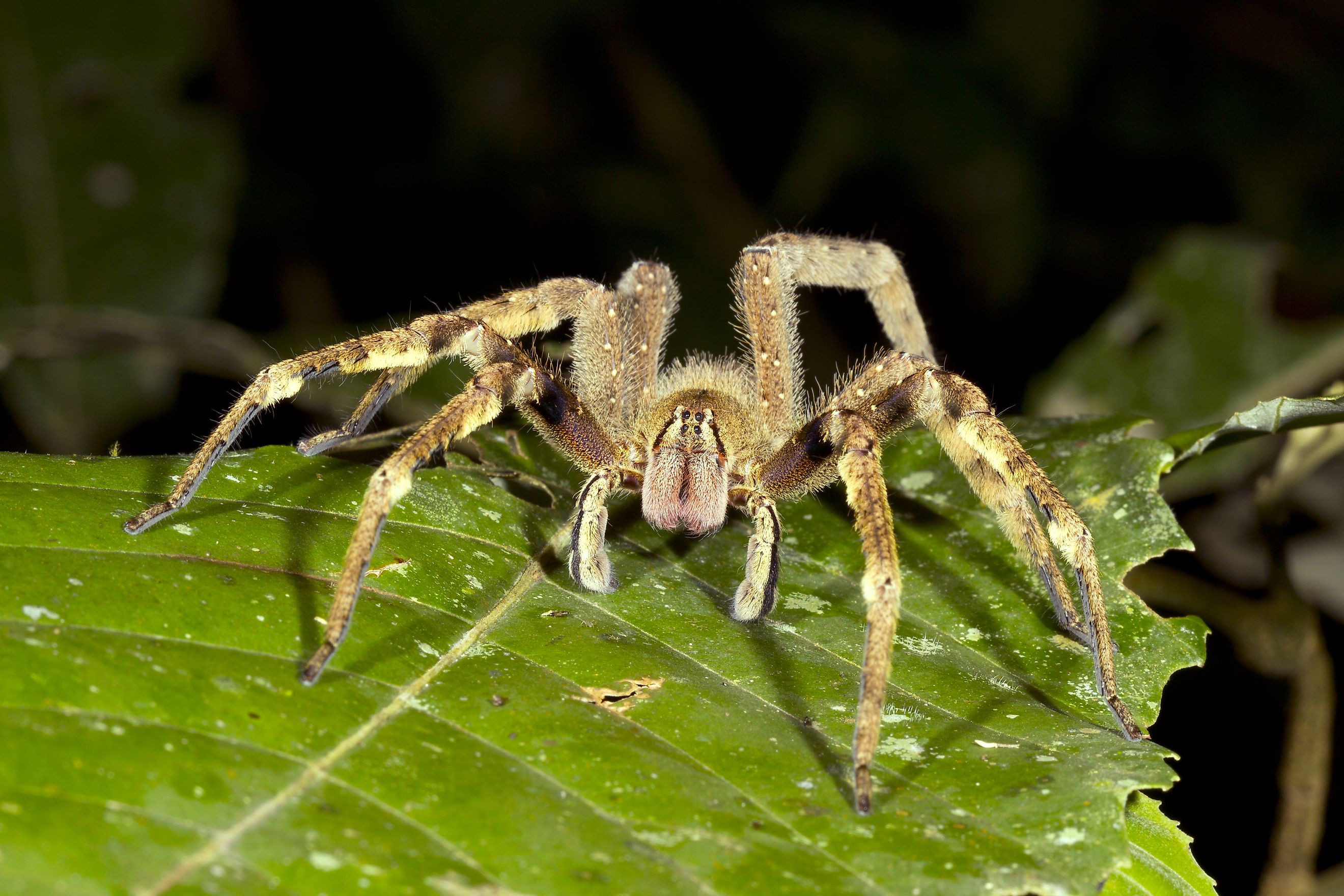
Top 11 Largest Spiders in the World
Spiders are a type of arachnid , as are mites, ticks , and scorpions . The creatures vary in size , from as small as a couple of millimeters to as large as 11 inches in leg span. Despite there being a plethora of different spiders, they have a similar appearance: an unsegmented body, and four pairs of legs , and they typically have eight eyes, though some may have six or fewer.
Spiders also have organs for producing silk—in other words, the material from which they make nests, webs, or cocoons. Spiders trap and immobilize prey (often smaller insects) with the silk, inject them with paralyzing venom, and then with a predigestive liquid. Finally, spiders suck the nutrients out of and consume their prey.
There are over 50,000 different spiders in the world, scattered all over different ecosystems and environments. Some live on the water, while others live in forests or the desert. The world's largest spiders vary in leg span and body mass. No matter whether one is an arachnophobe or arachnophile, the creatures are sure to inspire a little awe.
Goliath Bird-eating Tarantula ( Theraphosa blondi )
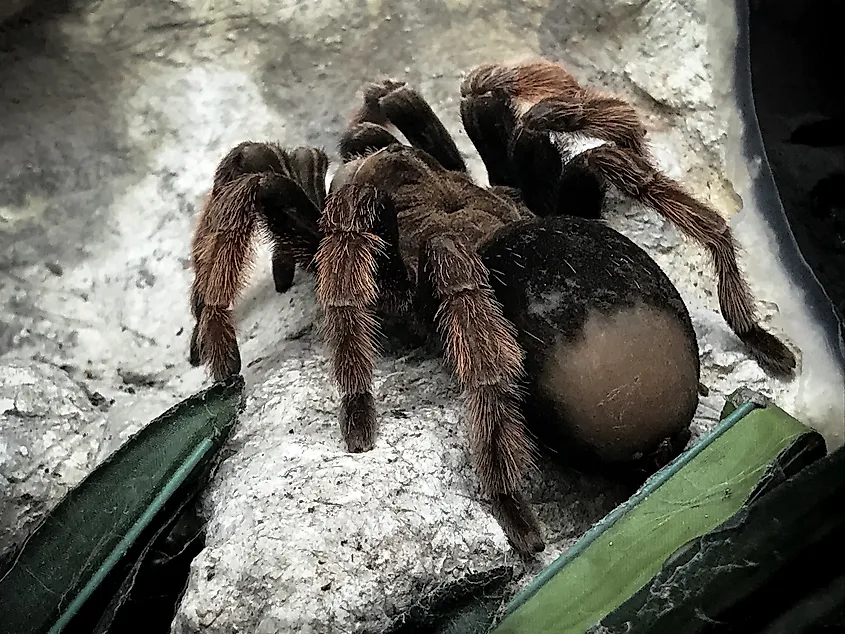
Close-up of a Goliath bird-eating tarantula, the largest tarantula species.
Goliath Bird-eating Tarantula ( Theraphosa blondi ), the biggest tarantulas in the world , live deep in the rainforests of South America , namely Venezuela , northern Brazil , Guyana , French Guiana , and Suriname . They have a deep brown or black coloring, two fangs, and chelicerae and pedipalps (additional appendages) near the mouth that act as fangs and claws and expel venom. The body of a Goliath Bird-eating Tarantula measures up to 4.75 inches, while the leg span reaches 11 inches. The tarantula weighs up to 6 ounces.
The male spiders typically live for three to six years, while females may survive up to 20 years. The creatures protect themselves by making a loud hissing noise or releasing sharp hairs into attackers, and make a meal out of smaller insects and animals, such as birds, mice, frogs, and lizards.
Giant Huntsman Spider ( Heteropoda maxima )
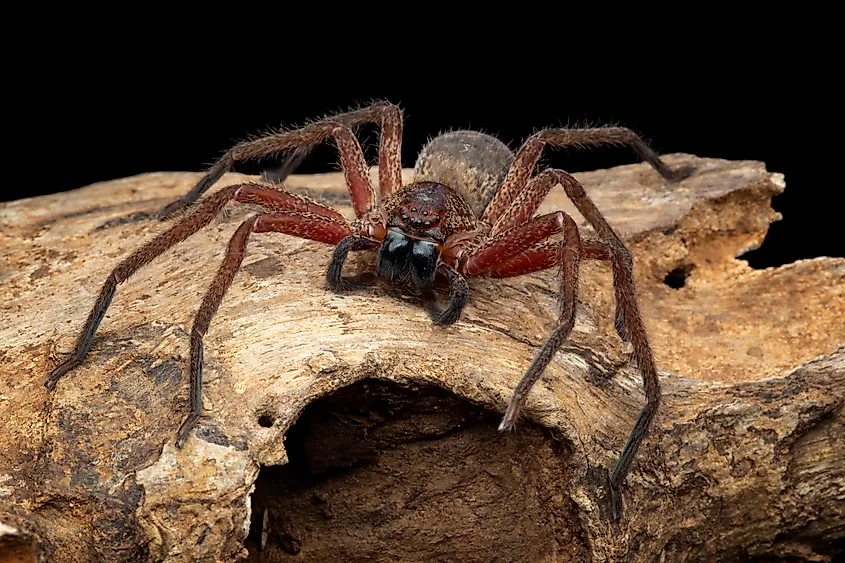
Close-up of Huntsman spiders on wood, Indonesian spiders.
The Giant Huntsman Spider ( Heteropoda maxima ) is only currently known to reside in certain limestone caves within Laos in Asia . The spiders are typically yellow-brown in color, with large black spots scattered irregularly on the back half of the body and dark bands on the legs.
The size of the Giant Huntsman Spider mirrors the leg span of the Goliath Birdeater Tarantula, reaching 12 inches. They typically have a 1.8-inch long body, weighing about 2.6 ounces because of the smaller body when compared to the Goliath Birdeater. However, females typically have larger bodies, while males have longer legs. Birds and small rodents or reptiles sustain the spiders for up to two years.
Brazilian Salmon Pink Birdeater ( Lasiodora parahybana )
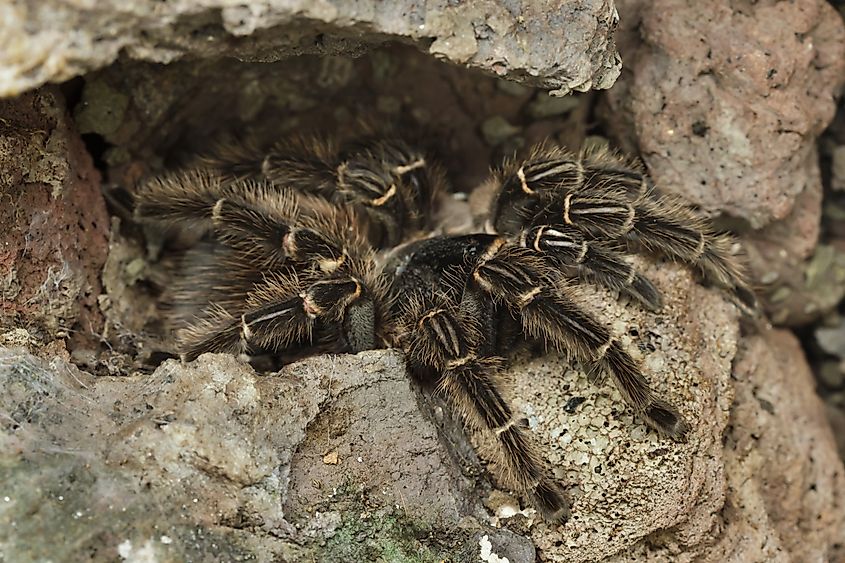
Brazilian salmon pink bird-eating tarantula (Lasiodora parahybana).
The Brazilian Salmon Pink Birdeater ( Lasiodora parahybana ) is the world's third largest spider, reaching a maximum size of 11 inches, though they typically grow to be 7 to 10 inches and weigh 3.5 ounces. They live in the tropical forests of eastern Brazil , with a velvety black abdomen and salmon-colored hairs from which they get their name.
The Brazilian Salmon Pink Birdeater reaches adult size in just two years. Male spiders live up to five years, while females have a lifespan of 15 years. They have self-protective urticating (prickly or stinging) hairs that cause itching or swelling. Brazilian Salmon Pink Birdeater spiders typically eat large insects or small amphibians or reptiles .
Chaco Golden-knee Tarantula ( Grammostola pulchripes )
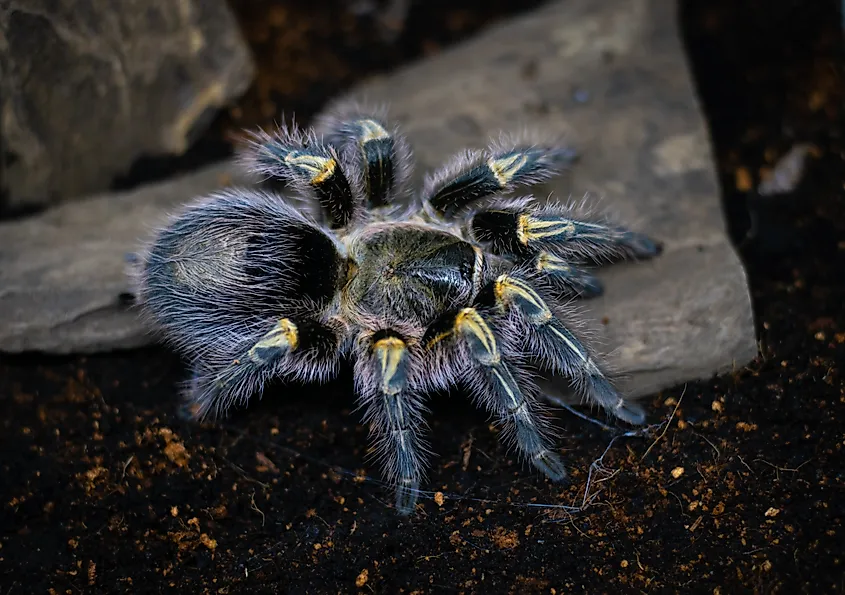
Chaco Golden Knee Tarantula (Grammostola pulchripes).
The Chaco Golden-knee Tarantula ( Grammostola pulchripes ) finds its home in Paraguay or Argentina, enjoying the more subtropical regions . The tarantula is known to reach between 7 to 8.5 inches in leg span. The spiders have mainly black bodies with golden stripes around the legs and pink hairs on the body. Like the Giant Huntsman Spider, males have smaller bodies and longer legs, while females have larger bodies. Also, males often live between five and seven years, while females live around 20 years. To defend itself, the spider may use its urticating hairs or burrow underground.
Face-Sized Tarantula ( Poecilotheria rajaei )
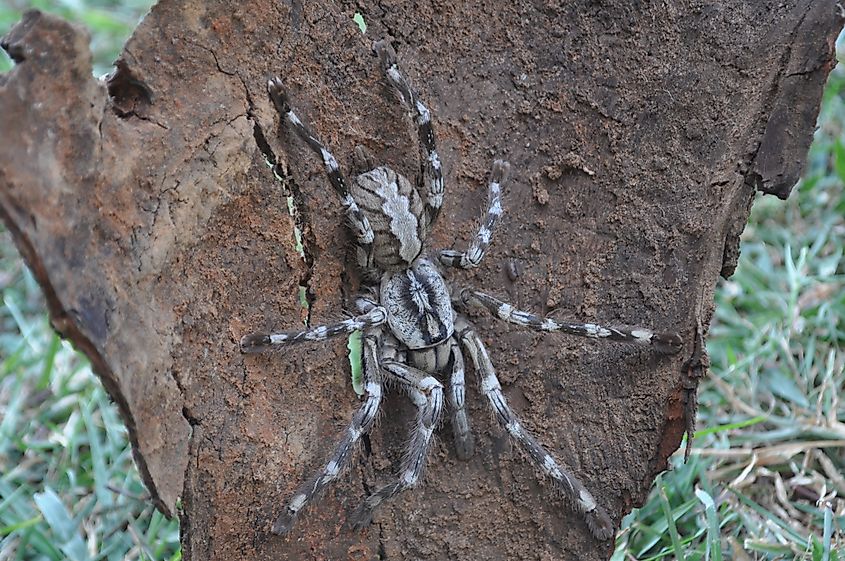
Tarantula: Poecilotheria rajaei. By Ranil Nanayakkara, CC BY 3.0, Wikimedia Commons
The Face-Sized Tarantula ( Poecilotheria rajaei ) is native to Sri Lanka and India, where it resides in the trees. It is a more recent discovery, as a dead specimen was found in 2009. The spiders are yellow, pink, and gray in color, with unique striping and piping that helps them camouflage in the wilderness. As they are quite rare and live in an area that suffers from deforestation , there is still much to discover about the tarantulas, but they boast a leg span of 8 inches—in other words, they are the size of a human face—and they eat small rodents, birds, lizards, and snakes.
King Baboon Spider ( Pelinobius muticus )
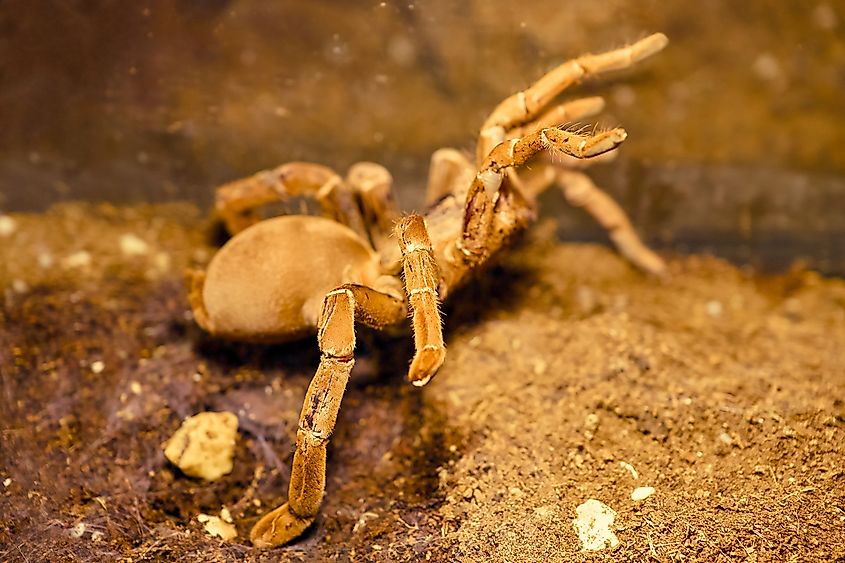
The King Baboon Spider ( Pelinobius muticus ) is an East African spider that lives in the shrublands and grasslands and is a dark reddish brown color. The spiders have urticating hairs, as well as stridulatory hairs, which rub together to create a whistling sound, acting as a defense mechanism. They are similar in size to the Face-Size Tarantula, reaching about 8 inches in leg span. The spiders typically burrow rather than create webs, using their silk near the entrance of their burrow to detect prey, such as beetles and cockroaches, through vibrations from motion. King Baboon Spiders live to be about 20 years.
Colombian Giant Tarantula ( Megaphobema robustum )
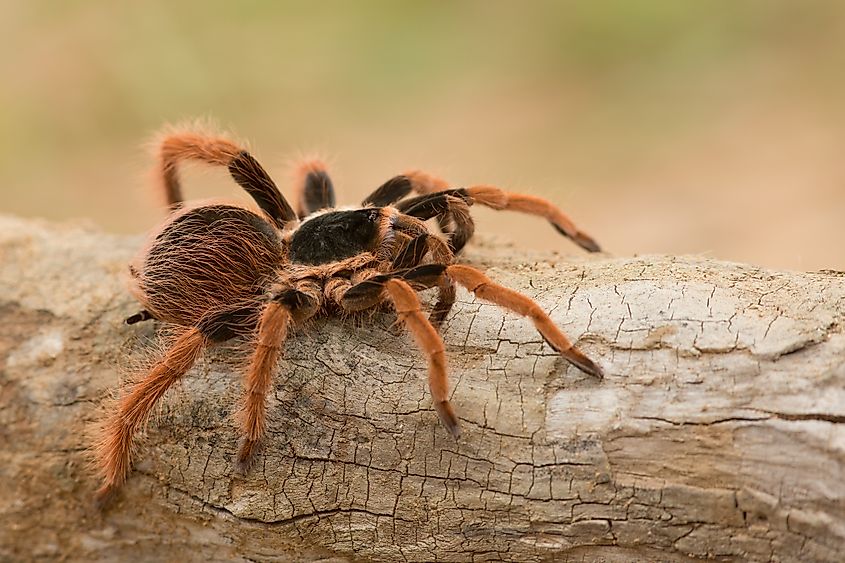
Colombian giant tarantula (Megaphobema robustum).
The Colombian Giant Tarantula ( Megaphobema robustum ) is another spider typically found in the tropical rainforests of Brazil and Colombia with a leg span of 6 to 8 inches. The tarantulas have a deep black coloring on their body and legs with bright orange hairs. They feed on large insects, small lizards, and mice. Like many other spiders, males live to be about four or five years, while female spiders live to be around 20 years. The Colombian Giant Tarantula is a bit more timid than others, typically burrowing or fleeing at a threat.
Brazilian Wandering Spider ( Phoneutria fera )
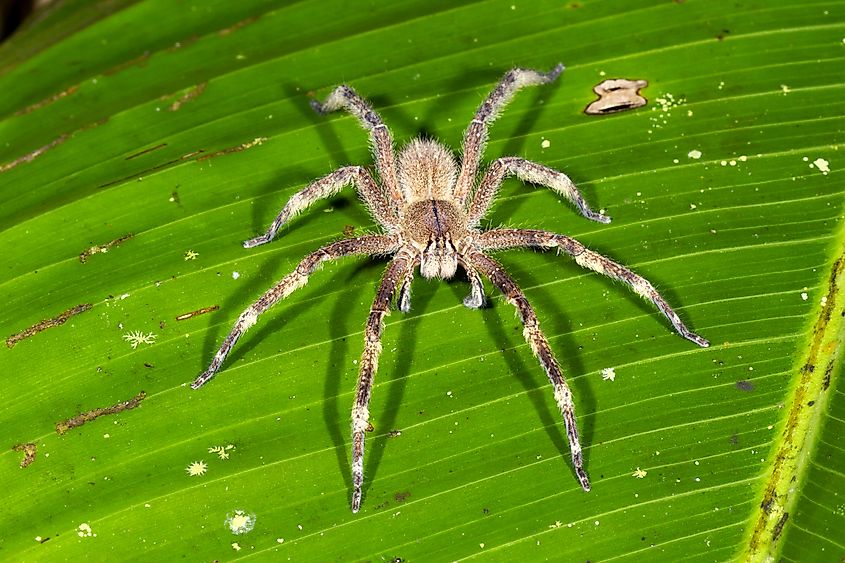
The Brazilian Wandering Spider ( Phoneutria fera ) or banana spider is one of the most venomous and deadliest spiders in the world—it makes sense that Phoneutria means "murderess" in Greek. The spider lives in Central and South America, from Costa Rica to Argentina. Their bodies reach about 2 inches in length, while the leg span reaches 7 inches. They are covered in small hairs with a gray/brown coloring and lightly colored spots on the abdomen.
Rather than building webs, they crawl on the forest floor and kill prey with a neurotoxic venom. They prey on flies, beetles, butterflies, moths, grasshoppers, locusts, and crickets and typically only bite larger animals in self-defense. Unlike many of the other world's largest spiders which have long lifespans, the Brazilian Wandering Spider only lives for about one year.
Brazilian Giant Tawny Red Tarantula ( Grammostola anthracina )
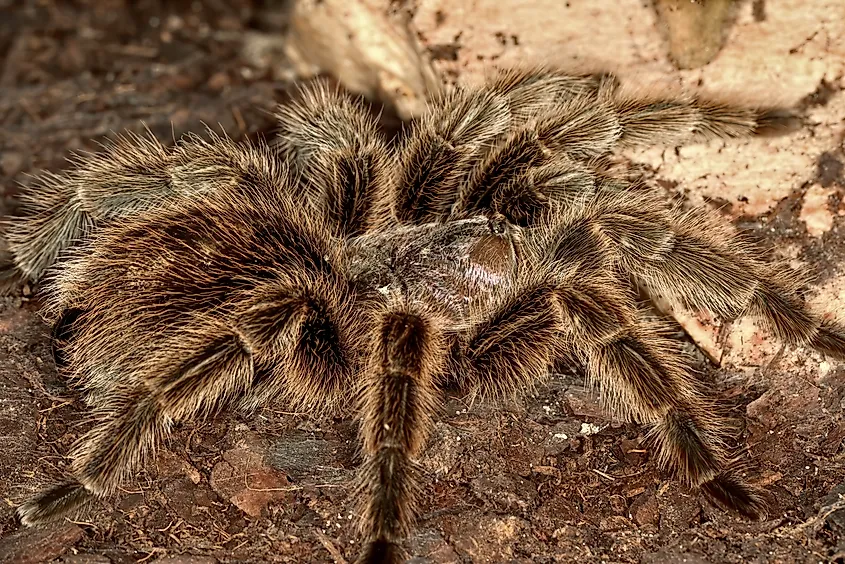
Grammostola anthracina spider on the ground.
Found in Uruguay , Paraguay , Brazil, and Argentina, the Brazilian Giant Tawny Red Tarantula ( Grammostola anthracina ) has an entirely brown body. Like the King Baboon Spider, the Brazilian Giant Tawny Red Tarantula uses stridulatory hairs as a defense mechanism. They grow between 5.5 and 6 inches and weigh about 6 ounces.
The Brazilian Giant Tawny Red Tarantula feeds on insects or small rodents, amphibians, and reptiles. The spiders are also said to have one of the longest lifespans of spiders, with reports of them surviving over 20 years.
Camel Spider ( Solifugae )
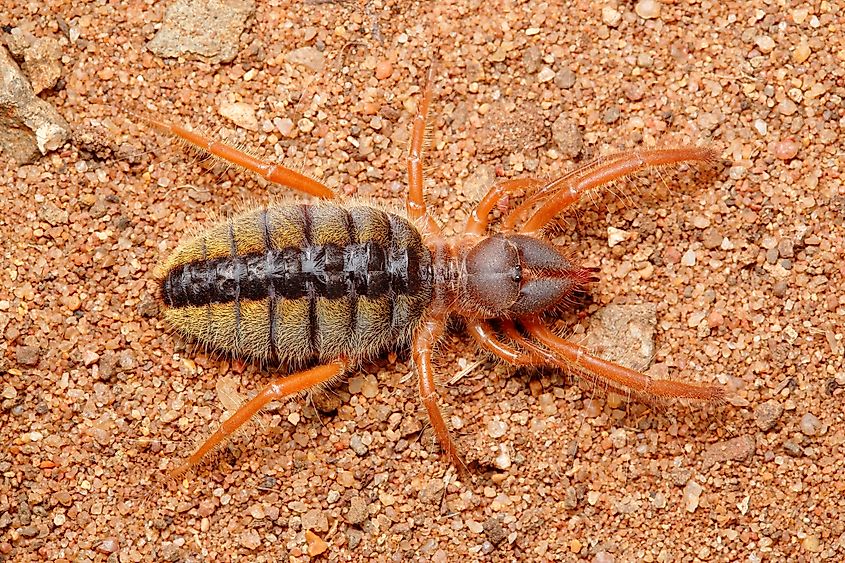
Camel spider (Solpugema) from Ndumo Game Reserve, South Africa.
Camel Spiders ( Solifugae ) are also known as wind scorpions, sun spiders, or solifuges. The creatures live in dry climates such as the southwestern United States , the Middle East , Mexico , and South Africa. They are not true spiders, sitting somewhere between spiders and scorpions. They are tan or dark brown in color and covered in fine hairs, helping them blend in and protecting them from heat. Reaching 5 to 6 inches in size, they generally feed on termites, beetles, rodents, snakes, lizards, and birds. Like the Brazilian Wandering Spider, the Camel Spider has a lifespan of one year.
Sand-dwelling Huntsman Spider ( Cerbalus Aravaensis )
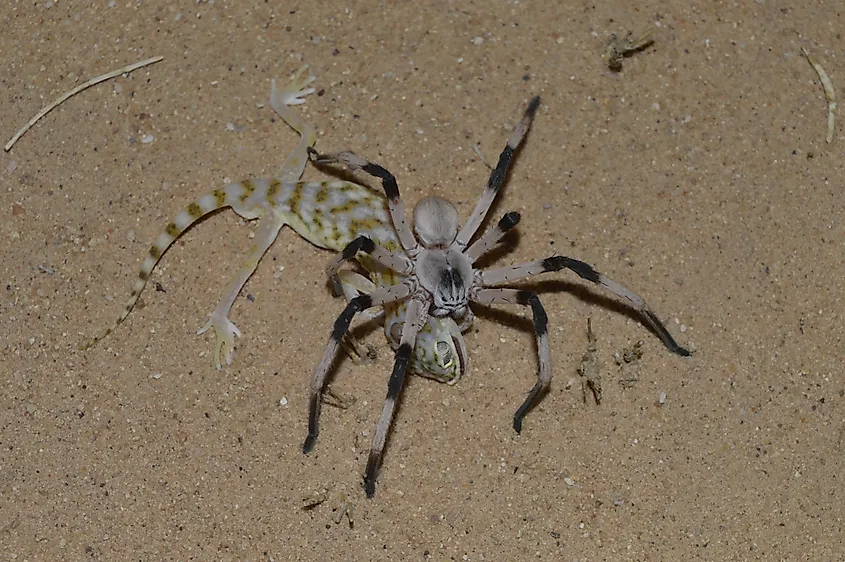
Cerbalus aravaensis: Biggest spider of the Middle East from Arava Valley preying on Stenodactylus doriae geckos.
Found in the sand dunes of Israel and Jordan , the Sand-dwelling Huntsman Spider ( Cerbalus Aravaensis ) is the smallest of the world's largest spiders, reaching 5.5 inches in leg span. Similar to the Giant Huntsman Spider and the Chaco Golden-knee Tarantula, males tend to have longer legs while females have larger bodies. The creatures are nocturnal and live underground. They have primarily gray to brown, flattened bodies, ideal for blending in with the landscape and slipping between rocks and tight places. The Sand-dwelling Huntsman Spider feeds on a variety of insects, lizards, and frogs and generally lives for two years or more.
Awe-Inspiring Arachnids: The Largest Spiders Revealed
The title of " World's Largest Spider " may belong to two different species: either the Goliath Bird-eating Tarantula or the Giant Huntsman Spider, each boasting their own weight and leg span. Regardless, the eleven largest spiders are some of the world's most interesting creatures. While some of them are venomous, they are not likely to be crawling around your home. Still, with knowledge of where they reside, arachnophobes are best to plan any upcoming vacations accordingly!
More in Nature
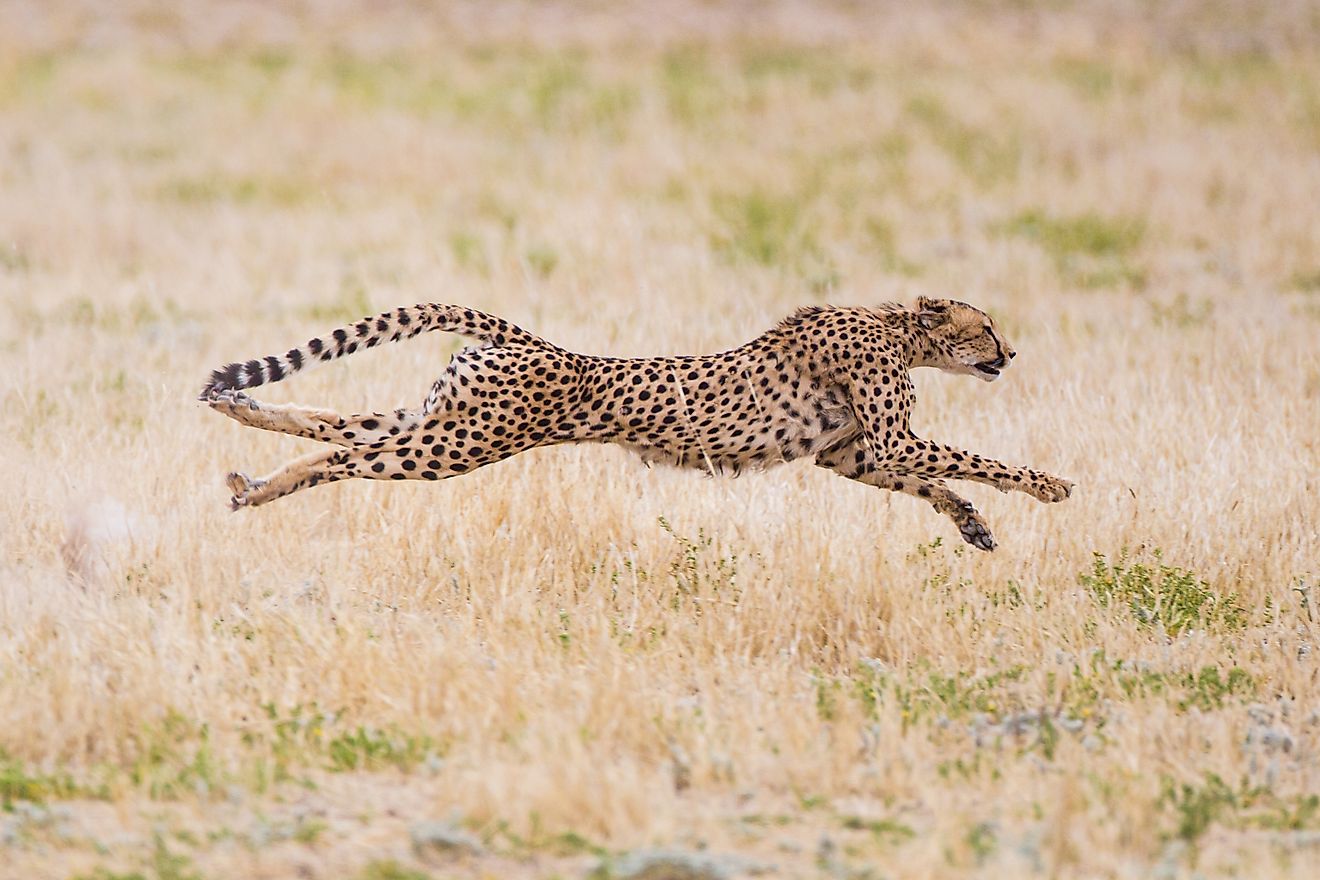
Why Are Cheetahs So Fast?

How Much Water is in Earth's Crust?
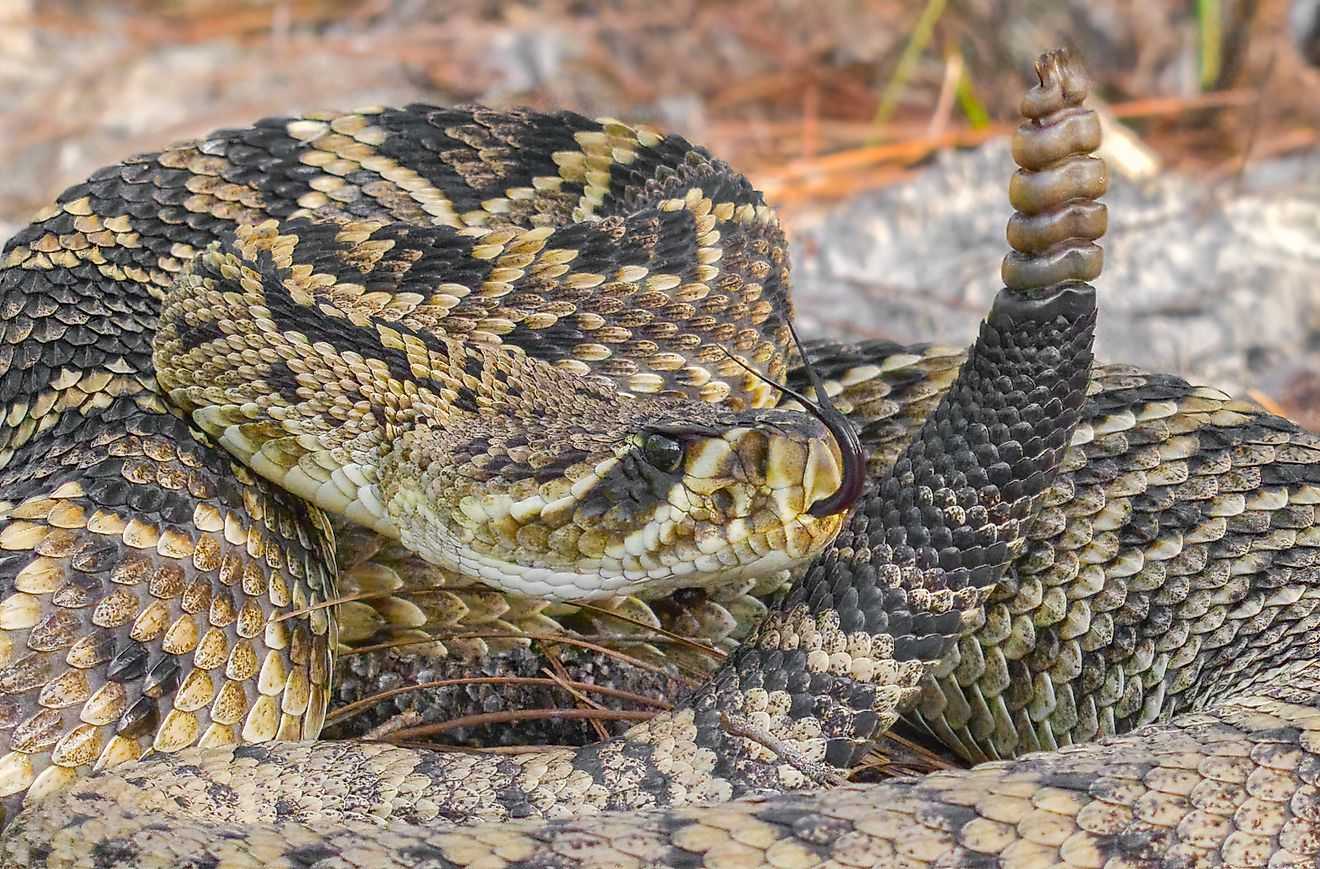
Which State Has More Venomous Snakes: Florida Or Arizona?
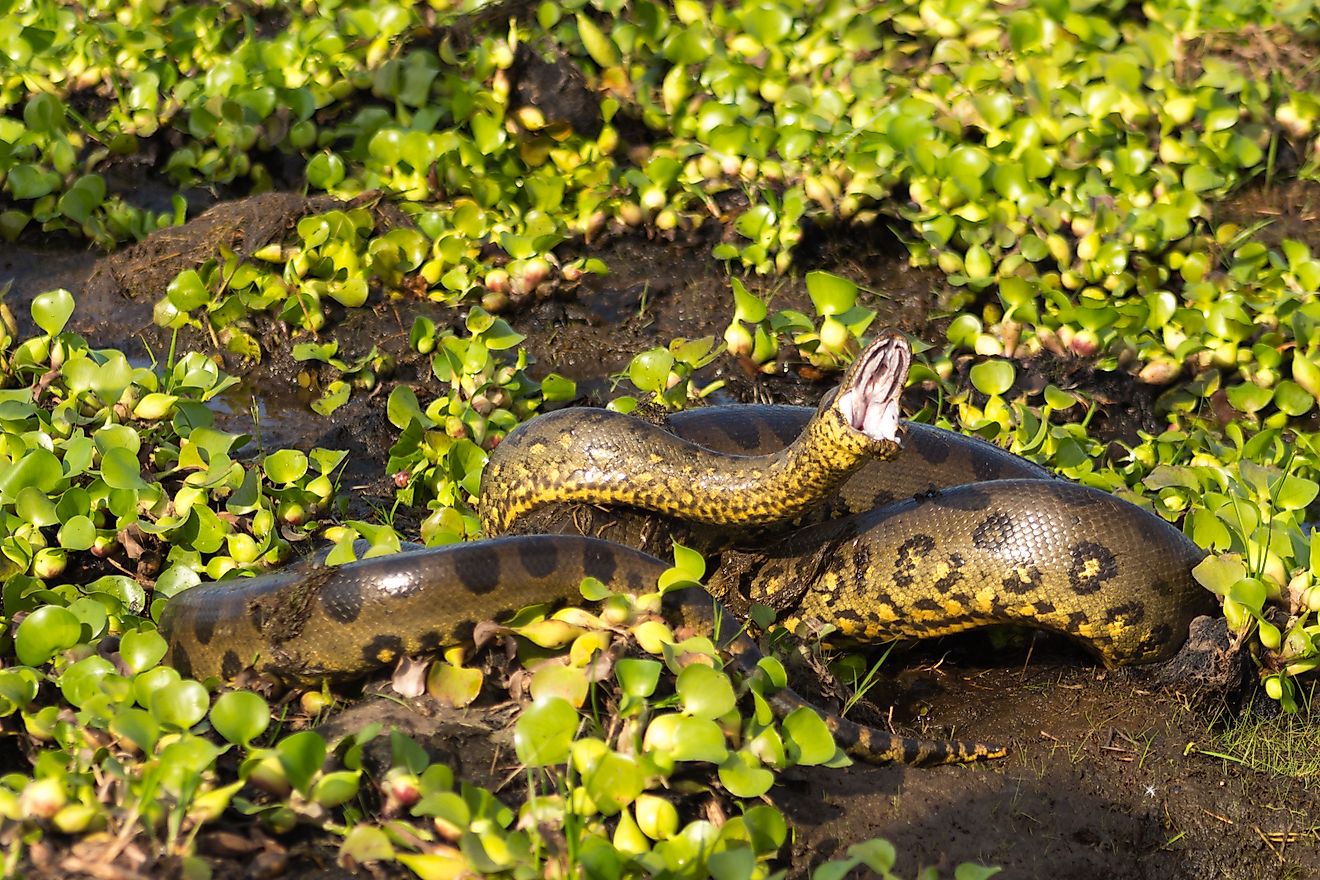
Scientists Discover The World’s Largest Snake Species
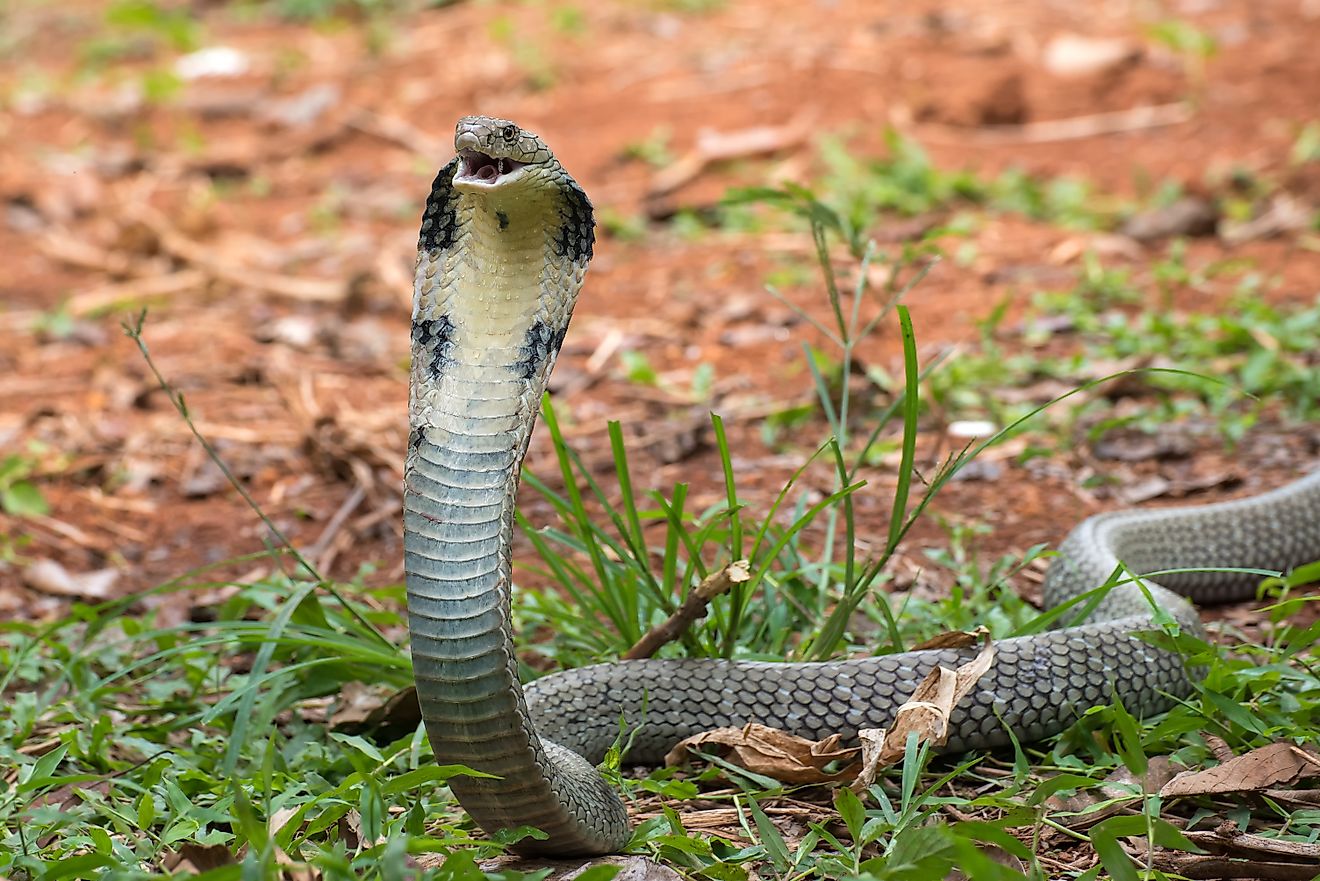
10 of the Fastest Snakes in the World
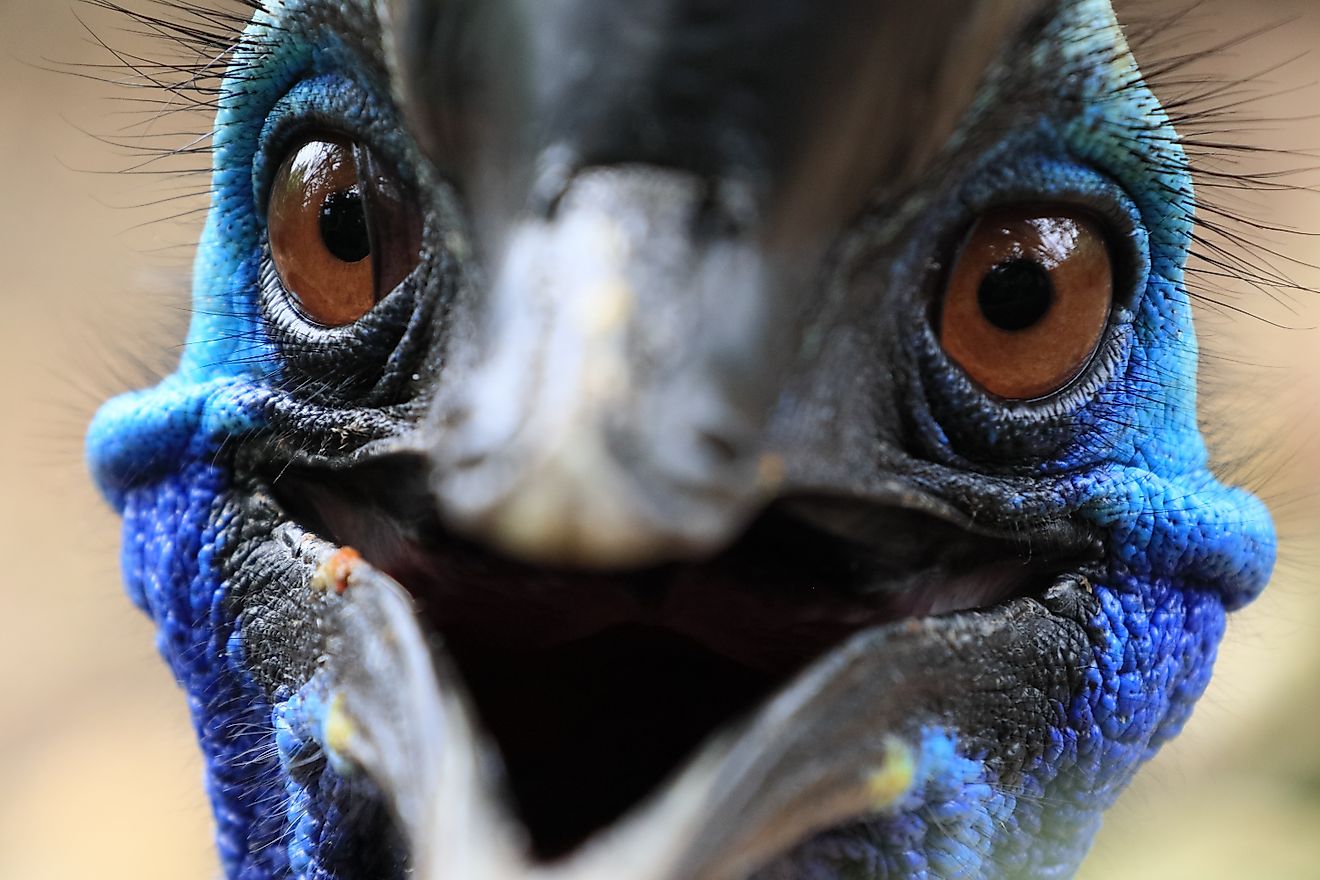
The World's Largest Birds
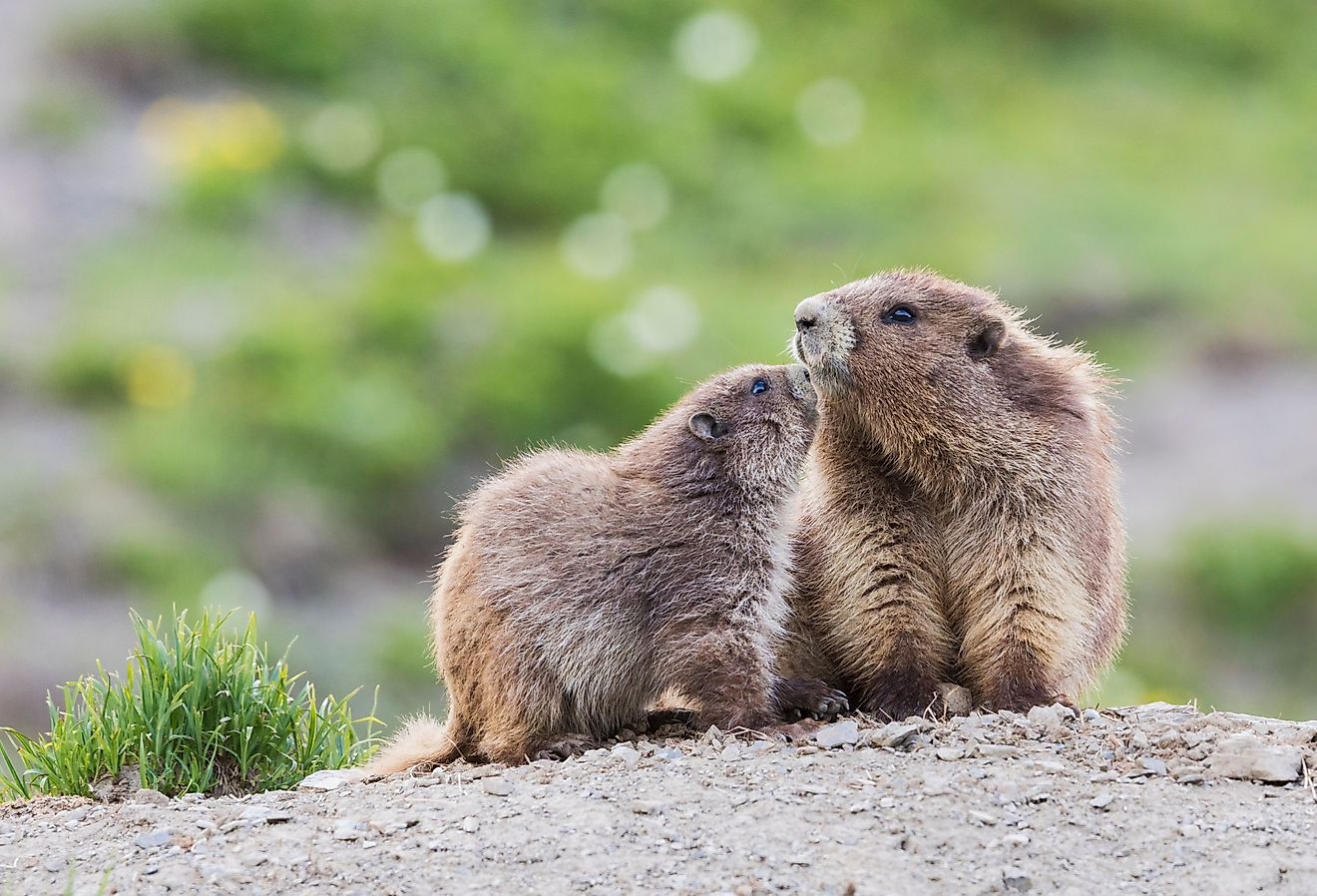
15 Animals Only Found In The United States
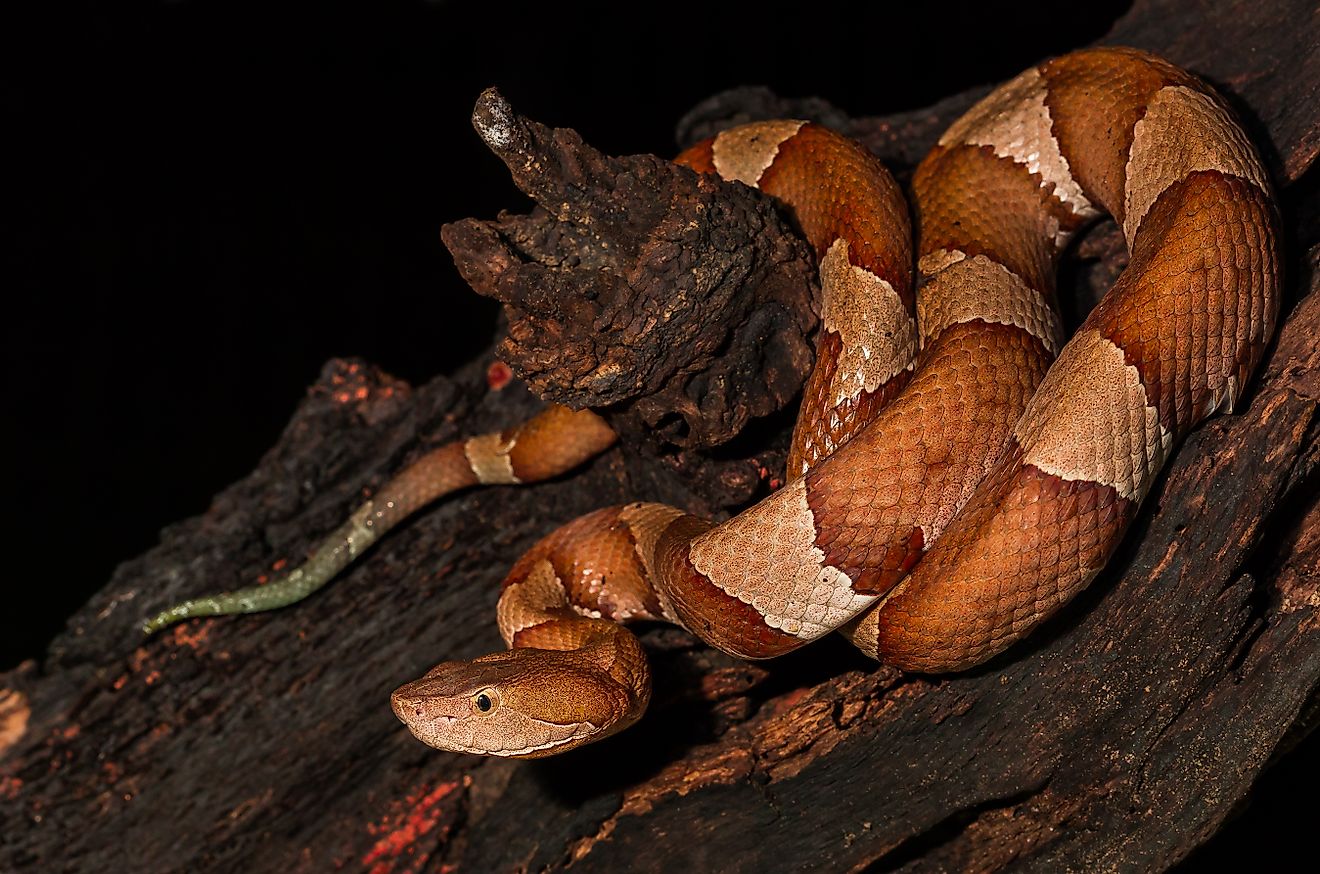
Are There Copperhead Snakes In The Everglades?

Melina Walling, Associated Press Melina Walling, Associated Press
Leave your feedback
- Copy URL https://www.pbs.org/newshour/science/everything-you-need-to-know-about-the-invasive-joro-spider
Everything you need to know about the invasive Joro spider
A large, brightly colored invasive species called the Joro spider is on the move in the United States. Populations have been growing in parts of the South and East Coast for years, and many researchers think it’s only a matter of time before they spread to much of the continental U.S.
But spider experts say we shouldn’t be too worried about them.
“My sense is people like the weird and fantastic and potentially dangerous,” said David Nelsen, a professor of biology at Southern Adventist University who has studied the growing range of Joro spiders. “This is one of those things that sort of checks all the boxes for public hysteria.”
READ MORE: Spiders fly on the currents of Earth’s electric field
Scientists instead worry about the growing prevalence of invasive species that can do damage to our crops and trees — a problem made worse by global trade and climate change, which is making local environmental conditions more comfortable for pests that previously couldn’t survive frigid winters.
“I think this is one of those ‘canary in the coal mine’ type species where it’s showy, it’s getting a lot of attention,” said Hannah Burrack, professor and chair of the entomology department at Michigan State University. But the shy critter poses little risk to humans. Instead, Burrack said, introduced pests like fruit flies and tree borers can do more damage.
“This is a global concern, because it makes all the things that we do in terms of conservation, in terms of agricultural production, in terms of human health, harder to manage,” she said.
What is the Joro spider?
The Joro spider is one of a group of spiders called orb-weavers, named for their wheel-shaped webs. They’re native to East Asia, have bright yellow and black coloring and can grow as long as three inches (8 cm) when their legs are fully extended.
However, they’re pretty hard to spot at this time of year because they’re still early in their life cycle, only about the size of a grain of rice. A trained eye can spot their softball-sized webs on a front porch, or their gossamer threads of golden silk blanketing the grass. Adults are most commonly seen in August and September.
Where are they headed?
Scientists are still trying to figure that out, said David Coyle, an assistant professor at Clemson University who worked with Nelsen on a study on the Joro’s range, published last November. Their central population is primarily in Atlanta but expanding to the Carolinas and southeastern Tennessee. A satellite population has taken hold in Baltimore over the last two years, Coyle said.
As for when the species will become more prevalent in the Northeast, an eventual outcome suggested by their research? “Maybe this year, maybe a decade, we really don’t know,” he said. “They’re probably not going to get that far in a single year. It’s going to take a bunch of incremental steps.”
Can they fly?
The babies can: using a tactic called “ballooning,” young Joro spiders can use their webs to harness the winds and electromagnetic currents of the Earth to travel relatively long distances. But you won’t see fully-grown Joro spiders taking flight.
What do they eat?
Joro spiders will eat whatever lands in their web, which mainly ends up being insects. That could mean they’ll compete with native spiders for food, but it might not all be bad — a Joro’s daily catch could also feed native bird species, something Andy Davis, a research scientist at the University of Georgia, has personally documented.
As for some observers’ hope that Joro spiders could gobble up the invasive spotted lanternflies destroying trees on the East Coast? They might eat a few, but there’s “zero chance” they’ll make a dent in the population, Coyle said.
Are they dangerous to humans?
Joro spiders have venom like all spiders, but they aren’t deadly or even medically relevant to humans, Nelsen said. At worst, a Joro bite might itch or cause an allergic reaction. But the shy creatures tend to stay out of humans’ way.
What could one day truly cause damage to humans is the widespread introduction of other creatures like the emerald ash borer or a fruit fly called the spotted wing drosophila that threaten the natural resources we rely upon.
“I try to stay scientifically objective about it. And that’s a way to protect myself from maybe the sadness of it. But there’s so much ecological damage being done all over the world for, for so many reasons, mostly because of humans,” Davis said. “This to me is just one more example of mankind’s influence on the environment.”
Support Provided By: Learn more
Educate your inbox
Subscribe to Here’s the Deal, our politics newsletter for analysis you won’t find anywhere else.
Thank you. Please check your inbox to confirm.

What’s behind recent extreme heat events and record high temperatures
World May 31

25 Most Dangerous Spiders in the World
T here are more than 43,000 species of spiders globally, but less than 30 have been responsible for human deaths. Much of it depends on the degree of venom in the bite and the size of the victim who has been bitten. Certain spider bites can take down a small animal, but very few are lethal to humans.
In most cases, a poisonous spider bite on humans results in pain, swelling, vomiting, dizziness, headaches, temporary paralysis and, in more severe cases, skin necrosis (the death of skin tissue). Fortunately, with the introduction of antivenom medication, there have been fewer spider-bite fatalities in the last 40 to 50 years.
Appearances can be misleading when it comes to spiders. A large, gnarly-looking spider may be completely harmless, yet some of the smallest arachnids have the deadliest bite. Here are 25 scary spiders that also happen to be the most dangerous in the world.
Yellow Sac Spider
Size: About half an inch
Location: Eastern and midwestern U.S.
What Makes This Scary Spider So Dangerous
The yellow sac spider is common in the U.S. and has a significant bite. These spiders do not build webs but construct sacs to stay in during the day. They only come out at night to hunt for food.
They often live in houses, especially during the early fall months when their food supply decreases. The yellow sac spider's fangs can pierce human skin easily. However, their bite is not deadly.
Wolf Spider
Size: About 1.5 inch
Location: Mostly in Texas, California and Missouri
These spiders have excellent eyesight due to the eight eyes on their head (two large ones, six smaller ones). Since they don't spin webs to trap prey, they must hunt for their food, usually consisting of large insects.
Female wolf spiders carry the egg sacs in their jaws, and once the babies hatch, they are carried on the mother's back for a week. Although these spiders can jump and pounce on prey, their bite does not threaten humans.
Noble False Widow Spider
Size: About 1 centimeter
Location: Originally from Madeira and the Canary Islands, but can now be found in Europe, North Africa, West Asia, South America and the U.S.
The noble false widow spider is the most common arachnid in the U.K, first spotted in the region in the 1870s. Although they resemble the black widow spider, their venom is not as potent. Their bite is primarily harmless, causing pain and swelling and hospitalization in a few severe cases.
These spiders are found in the upper corners of homes and buildings to catch flying insects. Their shiny abdomen is shaped like a skull and has distinctive markings that differentiate them from other species of widow spiders.
Cupboard Spider
Location: North America, Australia and New Zealand
Another type of false widow spider, the cupboard species, also resembles the deadly redback (sans the red stripe on the back). They build webs in dark areas both indoors and outdoors to snare their prey.
Although their bite is not dangerous to humans, minor skin lesions have occurred due to the bite. The male cupboard spider only lives for a few months, whereas the female can live two years.
Black House Spider
Size: About 1-inch long (with 1.25-inch leg span)
Location: Australia
The robust black house spider is primarily found in Australia but has also been spotted in New Zealand and Japan. This dark arachnid prefers an urban habitat and builds a triangular-shaped web in the corners of walls and windows.
The black house spider rarely bites humans unless it feels threatened. Its venom is not deadly, but symptoms that may occur from a bite include nausea, vomiting, sweating and skin necrosis.
Goliath Birdeater Tarantula
Size: 4.7-inch body (plus a leg span of 11 inches)
The humongous spider belongs to the tarantula family and one of the largest arachnids on the planet. When including their leg-span size, they are only second to the giant huntsman spider. The goliath birdeater's diet consists mainly of any living creatures smaller than them, including frogs, mice, lizards, snakes, bats and small birds.
Although their eyesight is poor, they rely on sensitive leg hairs to get around. Their venom is only deadly to their prey; it feels and reacts more like a wasp sting in humans.
Green Lynx Spider
Location: Mexico and Central America
The green lynx is a hunting spider that lives outdoors and frequents flowers and leaves where it camouflages to ambush its prey. These impressive arachnids are beneficial predators with their unique ability to spit venom nearly 8 inches and leap on crop pests.
They help balance garden ecosystems this way; however, they are also known to kill honeybees. The green lynx seldom bites humans, but its venom, although painful, is not deadly when it does.
Camel Spider
Size: 6 inches
Location: Deserts all over the world
Also known as the “Wind Scorpion,” these spiders have eight legs plus two extra leg-like appendages that are sensory organs. They are carnivorous creatures that eat other insects, lizards, small birds and rodents, using their strong jaws as a primary weapon.
Usually found in the desert areas of the Middle East, Mexico and the Southwestern U.S., the camel spider is nonvenomous and therefore not a threat to humans.
Blue-Footed Baboon Spider
Size: 7.9 inches (including leg span)
Location: South Africa
This South African spider earned its name for the sky-blue tips on the ends of its legs. These arachnids are hairy and have pads on their feet, giving them the appearance of a tarantula.
The blue-footed baboon spends most of its time in burrows or under rocks and logs. They are nocturnal hunters with fangs that deliver a painful bite to their victims. However, their venom is not poisonous to humans. If bitten, the worst symptom is a burning pain at the bite site.
Fringed Ornamental Tarantula
Size: Up to 10 inches in length
Location: Sri Lanka
Also known as the ornate tiger spider, this large tarantula from Sri Lanka lives in the holes of tall trees where it spins a funnel web. Their prey consists mainly of flying insects, which they catch and paralyze.
Although there are no records of human fatalities from a fringed ornamental tarantula bite, their venom is potent, causing intense pain and muscle cramping.
Trapdoor Spider
Size: 3.5 centimeters
Location: Japan, Africa, South America and North America
The trapdoor spider is also closely related to the tarantula family and has a stocky appearance with thin hairs covering its body. These spiders do not spin webs and prefer to live in warm habitats to burrow and create a trap door to catch their prey.
They eat all kinds of small insects, snakes, mice, frogs, baby birds and even fish. Trapdoor spiders are generally timid but will bite if provoked. They're non-toxic to humans, but their bite is significantly painful.
Six-Eyed Sand Spider
Size: 0.5-2 inches
Location: Southern Africa
The six-eyed sand spider is a close relative to the recluse spider and lives in the deserts of southern Africa. They camouflage themselves with sand articles to blend into the desert background and ambush their prey. Able to survive without food or water for long periods, this arachnid is well-adapted to desert life.
Although highly venomous, the six-eyed sand spider rarely bites humans but is capable of causing quite a bit of damage, including blood vessel leakage and tissue destruction.
Mouse Spider
Size: 1-3 centimeters
Muse spiders are aggressive arachnids with large fangs and stocky legs. They live in protective burrows and create trap doors to catch their prey, mainly wasps, centipedes, scorpions and bandicoots.
Very few produce venom toxic to humans, typically delivering a "dry bite" if harassed.
Hobo Spider
Location: Pacific Northwestern U.S.
Hobo spiders seek habitats in dark, damp places that have cracks, holes or crevices where they can build their funnel-shaped webs to trap bugs. The spider is common and earned its name from being found along railroad tracks in the Pacific Northwestern U.S.
Their venom is powerful enough to take down prey, but their bite is nearly painless for a human.
Katipo Spider
Size: Less than 1 centimeter
Location: New Zealand
Related to black widows and redbacks, this endangered arachnid lives in New Zealand and delivers a potent venom dangerous to humans. The katipo spider prefers living in the grasses and driftwood along the beach, feeding on ground-crawling bugs such as beetles.
Only the female is capable of biting, and if bitten by one, a human may experience pain, sweating, fever, shaking, abdominal cramping and, in rare cases, death if left untreated.
Chilean Recluse Spider
Location: Chili
One of the larger recluse species, the Chilean recluse spider is mainly found in the forest areas of Chile, Peru, Argentina, Ecuador, Uruguay, and the southern and eastern parts of Brazil. This long-legged, nocturnal spider has six eyes to help it see better in the dark when hunting for prey. But their unique metabolism enables them to go up to six months without food or water.
Depending on the potency of their bite, the effects from the Chilean recluse's injection may not appear until several hours later when blisters appear on the skin. Although most bites result in temporary skin irritation, some victims have experienced severe skin necrosis after being bit with the potent venom.
White Widow Spider
Size: 0.5-1 inch
Location: Russia, the Middle East and Central Asia
The white widow gets its name from its light coloring on the abdomen and its yellowish-brown legs. This species is not as dangerous as its black widow relative, but their bite still carries enough venom to be considered "medically significant."
The white widow builds a complex web in low-traffic areas to catch unsuspecting prey. They are rarely aggressive with humans unless startled or provoked.
Brown Recluse Spider
Size: About 1 inch
Location: Midwestern and South Central U.S.
The brown recluse is one of three dangerous spiders in North America with significantly potent venom that requires medical attention. One bite from this spider destroys cell membranes, leading to a breakdown of skin, fat and blood cells, effectively killing the surrounding tissue.
The brown recluse prefers living in dark, secluded areas around the house and is challenging to control since the females can produce 150-plus spiderlings yearly. Currently, there is no antivenom for these spider bites that leave gangrenous, open wounds on the skin. Seek medical attention immediately if you are bitten by one of these dangerous arachnids.
Black Widow Spider
Location: Northeastern U.S.
Considered the most venomous spider in North America, the Black Widow's bite is 15 times stronger than a rattlesnake's bite. Only the females are a threat to humans, though rarely does their venom cause fatalities in healthy humans. Effects from their bite include nausea, sweating, pain in the abdomen and back, muscle aches and difficulty breathing. Death can occur in severe cases involving the very young, the elderly and the sick.
The female black widow is easily identified by the red hourglass shape on its underside. They've earned their name from carrying out sexual cannibalism after mating, which explains the shorter lifespan of the male widows.
Brown Widow Spider
Location: Throughout the U.S.
The brown widow plays an essential role in our ecosystem by killing insects considered pests such as flies, mosquitos and digger wasps. They build their webs near vegetation in tropical areas or secluded places such as storage closets, garages and under cars.
Although the female brown widow's bite is poisonous, it is less harmful than the injection from a black widow. Their venom can cause swelling and redness in the bite area along with fever, joint pain and nausea, but other than these symptoms, they are not considered deadly.
Corner Funnel Weaver Spider
Size: 0.5-2 inches
Location: Throughout the U.S. and Canada
The corner funnel weaver is extremely fast on its legs and builds a funnel-shaped web to trap its prey. Like other funnel-web spiders, the arachnid has toxic venom and should be considered potentially dangerous to humans.
Symptoms from bites include a tingling sensation around the mouth, sweating, nausea, vomiting, headaches and high blood pressure. However, due to their small size, their fangs have difficulty penetrating human skin.
Red Widow Spider
Size: 1.5-2 inches
Location: Central and southern Florida in the U.S
The red widow gets its name from its bright reddish-orange coloring. They are primarily found in the sand dunes near sand pine vegetation, creating webs in palmetto bushes.
They are poisonous, but there is no record of bites from this species due to its tendency to avoid human contact. Although the females can lay 200 to 400 legs, the red widow is currently declared a threatened species in the U.S.
Sydney Funnel-Web Spider
There are at least 40 species of funnel web spiders, but the Sydney funnel web is one of the most venomous arachnids in Australia. Between 30 and 40 people are bitten by them yearly, and at least 13 deaths occurred from bites between 1927 to 1981. These spiders can kill a human within 15 minutes from a single bite.
Unlike many other arachnids, the males of this species have venom six times more toxic than the females. The poison is known to attack the victim's nervous system and affect the body's organs, causing a quick death. Fortunately, an antivenom was introduced in 1981and has since saved hundreds of lives.
Redback Spider
Location: Australia
Just like the name, these Australian spiders have a bright red mark on their back. They are extremely dangerous arachnids — one bite from this spider will lead to certain death if not treated immediately with an antivenom.
Redbacks prefer drier habitats but are capable of living in forests. Their webs can be found among rocks, logs, shrubs, tree hollows and even inside homes. Although their diet consists mainly of insects, they are cannibalistic creatures with females that eat their partners after mating and spiderlings eating their less-active siblings.
Brazilian Wandering Spider
Size: 2-6 inches
Location: Brazil
The Guinness Book of World Records considers the Brazilian wandering spider the most venomous in the world. They are brown, hairy spiders similar to the American Wolf spider in appearance but larger and far more toxic. Hundreds of people are bitten yearly by this dangerous arachnid, but a powerful antivenom has prevented death in most cases.
They are not necessarily aggressive but, if threatened, will rise up on their first two legs in a posture that serves as a warning that they are ready to attack. People bitten by the Brazilian wandering spider have reported symptoms such as nausea, abdominal cramping, high or low blood pressure, blurred vision, hypothermia, fast or slow heartbeat, convulsions, sweating and shock. Therefore, it is essential to seek immediate medical attention if bitten by one of these deadly arachnids.

- Search Please fill out this field.
- Manage Your Subscription
- Give a Gift Subscription
- Newsletters
- Sweepstakes
All About the Venomous Flying Spiders Invading This Summer — and When They're Coming to Your Area
Here's what to know about the Joro spiders arriving this summer, including the states they're expected to invade
:max_bytes(150000):strip_icc():format(webp)/skyler-byline-photo-88a543e2de8b4e68aa41cbb8844eff1f.png)
It's a bird! It's a plane! No, it's a parachuting venomous flying spider!
Called Joro spiders , these enormous arachnids have been spreading across North America since the 2010s and are expected to continue making their way up the East Coast this summer.
Georgia was the first state to experience the invasion of the Joro spiders, believed to have made their way from East Asia via shipping trucks or containers around 2013. They are native to China, Japan, Korea and Taiwan.
Whether you have arachnophobia or not, many East Coasters are bracing themselves for the Joro spiders' arrival due to their size and venomous nature (oh, and their ability to "fly"). The invasive species can have up to a 4-inch leg span and possess venom in their fangs.
But before your spider senses start tingling, these arachnids — scientifically titled, Trichonephila clavata (T. clavata) — are completely harmless despite their jarring characteristics. According to EarthSky , Joro spiders do not pose a threat to humans or pets and "may even be beneficial."
Plus, they don't technically "fly" in the avian sense. "Joro spiders utilize a technique known as ballooning, where they release silk threads into the air, allowing them to be carried by the wind," the New Jersey Pest Control shared .
National Geographic editor Christine Dell’Amore, who's led recent reporting on the Joro spider topic, tells PEOPLE exclusively that we "don't have to worry about them." She assures, "They're not going to sting you. They're not going to bite you."
Read on for what to know about the Joro spider's arrival, including when and where they're expected to invade the United States.
What do Joro spiders look like?
Joro spiders, scientifically called Trichonephila clavata, are described as invasive arachnids native to East Asia. Depending on the spider's gender, their characteristics differ. In contrast to male spiders' smaller size, adult females can grow to the size of one's hand.
Mature females are also vibrant in color in comparison to the males' relatively colorless brown, according to National Geographic . The females have striped legs and abdomens that look like "they've been dipped in a pool of swirling yellow, red, and black paint."
Joro spiders themselves are an exotic sight to see, but their three-dimensional webs are even more spectacular. Adult female spiders can spin strong webs that are yellow-gold in appearance and can span up to 10 feet, according to a study by University of Georgia's Department of Entomology .
When are the Joro spiders expected to arrive in the United States?
Joro spiders spend winter in their egg sacs, emerge in the warmer weather and grow in the months that follow making them easy to spot due to their striking size. Therefore, spotting them depends on where you reside because they haven't yet made their way up the entire East Coast.
In fact, most of the Joro spiders have already "arrived" — but due to their small size when they hatch from their eggs, they aren't as easy to spot compared to their matured appearance.
Which states will be affected by the Joro spiders?
In addition to Georgia, which was the first state graced by their presence around 2014, Joro spiders are expected to work their way up the East Coast with the use of their ballooning technique.
"Spiderlings of this particular group are really good dispersers because of the way they're able to spin a piece of silk. It kind of acts like a parachute, if you will, and gets dragged by the prevailing wind currents," study leader E. Richard Hoebeke , curator of arthropods at the Georgia Museum of Natural History, told National Geographic .
Data from a peer-reviewed study published in November 2023 showed that "there is an abundance of suitable habitat for T. clavata throughout eastern North America and in some areas in the western part of the continent."
"Those data show that this spider is going to be able to inhabit most of the eastern U.S. It shows that their comfort area in their native range matches up very well with much of North America," David Coyle, one of its authors, shared in a press release .
As of October 2022, the Joro spider's range spanned across Georgia, South Carolina, North Carolina and Tennessee. There were also reports of the species in Alabama, Maryland, Oklahoma and West Virginia.
José R. Ramírez-Garofalo, an ecologist at Rutgers University's Lockwood Lab, told the Staten Island Advance in April 2024 that "it is a matter of when, not if," the spiders make their way to New York and New Jersey.
However, National Geographic 's Dell’Amore tells PEOPLE that it's unlikely Joro spiders would make it up to New Jersey and New York from those states by this summer "that quickly."
She explains it can take "several generations for a spider to spread" despite the ballooning behavior the young spiderlings use to travel to different places. "It would take multiple years for them to reach the US Northeast."
The Royal Entomological Society's February 2022 study proved via lab experiment that Joro spiders "can exist in a colder climatic region," but Dell’Amore points out that "there isn't proof in real life yet that they can survive New England winters." She adds, "There's no evidence that they have made it to these states and established populations yet."
Are the Joro spiders dangerous to humans or pets?
Since Joro spiders are capable of living in "human-dominated landscapes," per a study published by the University of Georgia in February 2024, it makes sense why fear and anxiety are prevalent among many ahead of their arrival.
However, Joro spiders pose zero threat to humans or pets. Yes, they have venom in their fangs... like all spiders do!
David Nelson, a professor of biology at Southern Adventist University who has studied the growing range of Joro spiders, told NPR that a bite from one of these creatures might itch at worst or perhaps cause an allergic reaction.
According to a February 2023 University of Georgia study, Joro spiders have an "extremely shy and non-aggressive personality" as a result of an air puff test that caused them to remain "in a frozen state" for over an hour!
EarthSky notes that Joro spiders "may even be beneficial" to us. The site explains, "The spiders eat insects such as stink bugs, which cause crop damage and swarm in homes. They can help control insects without the use of pesticides."
Should Joro spiders be killed?
Whether you're arachnophobic or not, Dell’Amore tells PEOPLE "there's no need to kill spiders when you see them." That goes for Joro spiders, too.
"There are only very few spiders that are actually harmful to people and those are black widows and brown recluse spiders," she points out. "The vast majority of spiders are eating pests and playing important roles in the ecosystem."
In fact, Dell’Amore says spiders "don't want to interact with us." Therefore, she stresses "we should be good neighbors to them, let them do their thing and we do our own thing." She adds, "We can coexist peacefully."
Related Articles
More From Forbes
3 reasons venomous ‘flying’ spiders aren’t so scary, from a biologist.
- Share to Facebook
- Share to Twitter
- Share to Linkedin
The Joro spider is a giant among spiders, with females growing to the size of a human palm. People ... [+] are worried about their spread, but here’s why the invasion isn’t as scary as it may seem.
There are over 50,000 species of spiders in the world , but it’s the Joro spider that has large parts of the East Coast on edge.
Originating from East Asia, particularly Japan, China and Korea, Joro spiders ( Trichonephila clavata ) stand out for their striking size, almost villainous appearance and their stowaway-approach to migration —they don’t exactly fly. Experts believe the Joro spiders spread to other regions of the world by “flying” their way on to human transportation systems, most likely cargo ships. That’s why arachnophobes in the United States are worried the spiders could show up in the East Coast cities this summer .
But don’t panic yet. Here are three essential facts to consider before getting caught up in the frenzy about the Joro spiders.
1. Joro Spiders Are Venomous, But Unlikely To Hurt Humans And Pets
Unless you have a tendency to itch yourself to death, a Joro spider’s venom is unlikely to do any serious damage to you. The same goes for any pets in your household. The worst possible outcome is an allergic reaction and the best possible outcome is that you (or your pets) will never have to engage in a face-off, as these arachnids are extremely shy.
Despite the colorful aposematism , Joro venom is not very effective on creatures larger than the typical insect.
While the brilliant color of Joro spiders suggests that they are highly venomous, this is not the ... [+] case.
Best High-Yield Savings Accounts Of 2024
Best 5% interest savings accounts of 2024, 2. joro spiders could positively impact local ecology.
Last year, researchers collected 213 female Joro spiders from their webs in Georgia and South Carolina to analyze their diets. Sexual dimorphism (a biological phenomenon in which males and females of the same species exhibit different physical characteristics beyond their sexual organs) is pronounced in these spiders.
Females are not only larger, with leg spans that can extend up to 4 inches, but are also more vividly colored. They typically showcase a brilliant yellow on their bodies with striking blue and red markings, making them easy to tell apart from males, which are significantly smaller and less colorful, predominantly featuring a subdued blue-black hue that makes them less noticeable.
The researchers examined both the spiders’ guts and the remains of prey found in their webs. By identifying what these spiders eat, they were able to infer their role in the local ecosystem. This provides valuable clues as to what could happen if the spiders made their way to the tristate area.
Joro spiders have a varied diet that includes many types of insects, some of which are considered pests, according to the paper published by these researchers. Here’s a quick look:
- Beetles and flies, which can sometimes be pests
- True bugs like aphids and stink bugs, known for damaging plants by sucking their sap
- Wasps, bees and ants, which can be bothersome in large numbers, though they are often beneficial
- Moths and butterflies, whose larvae can be agricultural pests
- Mosquitoes, notorious for spreading diseases and being a general nuisance
Based on these findings, Joro spiders could significantly contribute to natural pest control if they establish themselves in the East Coast. Their ability to consume a wide range of insects that are often detrimental to agriculture and human comfort suggests they could help more than harm.
3. Joro Spiders Can ‘Fly,’ But Not Like A Winged Insect Can
Like a few other species of spiders, Joro spiders utilize a fascinating method of movement known as “ballooning” to travel. This doesn’t involve wings; instead, young spiders and sometimes adults release long strands of silk that catch the wind, parachuting them into the air and carrying them over potentially vast distances. This method of dispersal can be quite effective, allowing these spiders to colonize new areas rapidly.
The concept of venomous spiders flying through the air can seem alarming, but it’s important to note that while ballooning enables Joro spiders to move to new regions, it doesn’t mean they will have control on where they’ll land, or that they’ll thrive everywhere they land. Local climate, availability of food and other ecological factors will play crucial roles in determining their success in new environments.
Within the country, Joro spiders are currently found primarily in Georgia. Although ballooning aids their spread, the species is more likely to reach the tristate area by hitchhiking on interstate vehicles. As part of their ongoing U.S. tour, Joro spiders have also been observed in South Carolina, North Carolina and Tennessee, with some reports of their presence in Oklahoma, West Virginia and Maryland.
Despite the recent hoopla about the Joro spider spreading across the U.S., the best thing to do, as fellow residents of the planet, is to let these shy, industrious web-weaving creatures be—especially since they are likely helping us control pest populations.

- Editorial Standards
- Reprints & Permissions
Join The Conversation
One Community. Many Voices. Create a free account to share your thoughts.
Forbes Community Guidelines
Our community is about connecting people through open and thoughtful conversations. We want our readers to share their views and exchange ideas and facts in a safe space.
In order to do so, please follow the posting rules in our site's Terms of Service. We've summarized some of those key rules below. Simply put, keep it civil.
Your post will be rejected if we notice that it seems to contain:
- False or intentionally out-of-context or misleading information
- Insults, profanity, incoherent, obscene or inflammatory language or threats of any kind
- Attacks on the identity of other commenters or the article's author
- Content that otherwise violates our site's terms.
User accounts will be blocked if we notice or believe that users are engaged in:
- Continuous attempts to re-post comments that have been previously moderated/rejected
- Racist, sexist, homophobic or other discriminatory comments
- Attempts or tactics that put the site security at risk
- Actions that otherwise violate our site's terms.
So, how can you be a power user?
- Stay on topic and share your insights
- Feel free to be clear and thoughtful to get your point across
- ‘Like’ or ‘Dislike’ to show your point of view.
- Protect your community.
- Use the report tool to alert us when someone breaks the rules.
Thanks for reading our community guidelines. Please read the full list of posting rules found in our site's Terms of Service.
They're big. They're colorful. But Joro spiders aren't nightmare fodder
Joro spiders — invasive, brightly colored, orb-weaving arachnids that have been spreading in the U.S. for the past several years — have captured the public’s interest and horror once again
A large, brightly colored invasive species called the Joro spider is on the move in the United States. Populations have been growing in parts of the South and East Coast for years, and many researchers think it’s only a matter of time before they spread to much of the continental U.S.
But spider experts say we shouldn’t be too worried about them.
“My sense is people like the weird and fantastic and potentially dangerous,” said David Nelsen, a professor of biology at Southern Adventist University who has studied the growing range of Joro spiders. “This is one of those things that sort of checks all the boxes for public hysteria.”
Scientists instead worry about the growing prevalence of invasive species that can do damage to our crops and trees — a problem made worse by global trade and climate change , which is making local environmental conditions more comfortable for pests that previously couldn’t survive frigid winters.
“I think this is one of those ‘canary in the coal mine’ type species where it’s showy, it’s getting a lot of attention,” said Hannah Burrack, professor and chair of the entomology department at Michigan State University. But the shy critter poses little risk to humans. Instead, Burrack said, introduced pests like fruit flies and tree borers can do more damage.
“This is a global concern, because it makes all the things that we do in terms of conservation, in terms of agricultural production, in terms of human health, harder to manage,” she said.
WHAT IS THE JORO SPIDER?
The Joro spider is one of a group of spiders called orb-weavers, named for their wheel-shaped webs. They’re native to East Asia, have bright yellow and black coloring and can grow as long as three inches (8 cm) when their legs are fully extended.
However, they’re pretty hard to spot at this time of year because they’re still early in their life cycle, only about the size of a grain of rice. A trained eye can spot their softball-sized webs on a front porch, or their gossamer threads of golden silk blanketing the grass. Adults are most commonly seen in August and September.
WHERE ARE THEY HEADED?
Scientists are still trying to figure that out, said David Coyle, an assistant professor at Clemson University who worked with Nelsen on a study on the Joro’s range, published last November . Their central population is primarily in Atlanta but expanding to the Carolinas and southeastern Tennessee. A satellite population has taken hold in Baltimore over the last two years, Coyle said.
As for when the species will become more prevalent in the Northeast, an eventual outcome suggested by their research? “Maybe this year, maybe a decade, we really don’t know,” he said. “They’re probably not going to get that far in a single year. It’s going to take a bunch of incremental steps.”
CAN THEY FLY?
The babies can: using a tactic called “ballooning,” young Joro spiders can use their webs to harness the winds and electromagnetic currents of the Earth to travel relatively long distances. But you won’t see fully-grown Joro spiders taking flight.
WHAT DO THEY EAT?
Joro spiders will eat whatever lands in their web, which mainly ends up being insects. That could mean they’ll compete with native spiders for food, but it might not all be bad — a Joro’s daily catch could also feed native bird species, something Andy Davis, a research scientist at the University of Georgia, has personally documented.
As for some observers’ hope that Joro spiders could gobble up the invasive spotted lanternflies destroying trees on the East Coast? They might eat a few, but there’s “zero chance” they’ll make a dent in the population, Coyle said.
ARE THEY DANGEROUS TO HUMANS?
Joro spiders have venom like all spiders, but they aren’t deadly or even medically relevant to humans, Nelsen said. At worst, a Joro bite might itch or cause an allergic reaction. But the shy creatures tend to stay out of humans’ way.
What could one day truly cause damage to humans is the widespread introduction of other creatures like the emerald ash borer or a fruit fly called the spotted wing drosophila that threaten the natural resources we rely upon.
“I try to stay scientifically objective about it. And that’s a way to protect myself from maybe the sadness of it. But there’s so much ecological damage being done all over the world for, for so many reasons, mostly because of humans,” Davis said. “This to me is just one more example of mankind’s influence on the environment.”
The Associated Press’ climate and environmental coverage receives financial support from multiple private foundations. AP is solely responsible for all content. Find AP’s standards for working with philanthropies, a list of supporters and funded coverage areas at AP.org .


IMAGES
VIDEO
COMMENTS
Bites and venom. Brazilian wandering spiders' venom is a complex cocktail of toxins, proteins and peptides, according to the Natural History Museum in Karlsruhe, Germany. The venom affects ion ...
Here are a few more notable characteristics of the Wandering Spider: Females are larger than males, with a body length of up to 1.6 inches (4 cm). They have eight eyes, arranged in two rows, which help them in hunting. The Wandering Spider is primarily found in Central and South America, particularly in Brazil.
Phoneutria is a genus of spiders in the family Ctenidae.They are mainly found in northern South America, with one species in Central America. Members of the genus are commonly referred to as Brazilian wandering spiders. Other English names include armed spiders (armadeiras in Brazilian Portuguese) and banana spiders (a name shared with several others).
Wandering spiders (Ctenidae) are a family of spiders that includes the Brazilian wandering spiders.These spiders have a distinctive longitudinal groove on the top-rear of their oval carapace similar to those of the Amaurobiidae. They are highly defensive and venomous nocturnal hunters. Wandering spiders are known to hunt large prey, for example hylid species Dendropsophus branneri.
The Brazilian Wandering Spider (Phoneutria fera) is an aggressive and highly venomous spider. It was first discovered in Brazil hence its name. ... Phoneutria nigriventer (two species of wandering spider) are the two most commonly implicated as the most vicious and deadly of the Phoneutria spiders.
Phoneutria nigriventer is a species of medically significant spider in the family Ctenidae, found in the Southern Cone of South America (Brazil, Uruguay, Paraguay, and Argentina). Along with other members of the genus, they are often referred to as Brazilian wandering spiders.. Its bite can cause severe symptoms, including increased pulse, blood pressure, and respiratory rate; extraordinary ...
The venom glands of the Brazilian Wandering Spider are over a centimetre long, and this is all housed inside the bright red chelicerae (mouth parts) which they are quick to display whenever they get upset. 1. 4. They're aggressive. These spiders can grow quite large and have long, brightly-coloured legs.
When you think of deadly spiders, there are a few names that spring to mind - but none more infamous than the Brazilian Wandering Spider. This species is reputed to have the most toxic venom of any spider, having a bite which causes horrendous side-effects like priapism and convulsions. ... The Brazilian Wandering Spider's diet consists ...
Brazilian wandering spiders are the most poisonous spiders on the planet. They belong to the genus Phoneutria, which consists of a number of spider species. A couple of these species, including Phoneutria nigriventer, P. keyserlingi and P. fera are referred to as Brazilian wandering spiders.
wandering spider, (family Ctenidae), any member of the family Ctenidae (order Araneida), a small group of large spiders of mainly tropical and subtropical regions, commonly found on foliage and on the ground. Their first two legs are armed with strong bristles on the lower side. Cupiennius salei, found in rainforests in Central and South America, has a characteristic banding pattern on its ...
Brazilian wandering spider brazilian wandering spider size Their body length ranges from 17 to 48 mm (43⁄64 to 1+57⁄64 in).Phoneutria are impressive spiders reaching body sizes up to 3.5 centimeters and leg spans up to 15 centimeters. They are nocturnal, hunting at night, and hiding in dark places during the…
Victims of a Brazilian wandering spider bite can reportedly be killed in an hour. But few deaths occur because an effective anti-venom is available in Brazil and Guinness claims that people are ...
The Brazilian Wandering Spider is a hunter of incredible power and once it targets its victim, the outcome is certain. Subscribe: http://bit.ly/NatGeoSubs...
The inland taipan has more powerful venom than the Brazilian wandering spider. The snake delivers anywhere between 44mg and 110mg of venom, but the LD50 (a measure of venom potency) of the snake is .025mg/kg. In other words, this snake has enough venom to kill 280 humans with a single bite, causing death in less than an hour.
The Brazilian Wandering Spider, Funnel-web Spider, Black Widow Spider, Yellow sac spider and Brown Recluse Spider are among the world's deadliest arachnid species.These spiders are known to cause extreme pain in their victims, including humans, and some of their bites are even deadly! Some of us have a love-hate relationship with spiders; we find the tiny ones adorable or helpful (with ...
There is some debate around this topic. But, according to CBS News, ten of the deadliest spiders include: Sydney funnel-web spider. Redback spider. Chilean recluse spider. Brazilian wandering ...
This Encyclopedia Britannica list introduces 9 dangerous and deadly spiders. This Encyclopedia Britannica list introduces 9 dangerous and deadly spiders. ... London, England, had to move out of their home so it could be fumigated, because it became infested with tiny Brazilian wandering spiders. An egg sac deposited in a banana bunch was ...
The South American wandering spiders from the genus Phoneutria, and the Australian funnel-webs from the family Atracidae. These constitute arguably the most ...
The Brazilian wandering spider, aka armed spider or banana spider, is a highly aggressive and deadly spider found throughout Central and South America. It's bite can not only be painful but deadly! There are 5 known comparative species whose members are also incredibly venomous. It is arguably the world's deadliest spider.
Brazilian Wandering Spiders (aranhas armadeiras), Phoneutria nigriventer, P. keyserlingi and P. fera, are sometimes said to have the world's most toxic spider venom - probably based on a well publicized study where mice were killed by intravenous injection of as little as 0.006 mg of venom. Since I'm a man, not a mouse, that doesn't worry me ...
The spider is collected and taken to a local "authority" who typically has no arachnological experience. A quick search of the Internet leads the "authority" to identify the spider as a deadly armed or wandering spider of Brazil (genus Phoneutria) and then, panic and hyperbolic media coverage ensues. However, most of the time, these ...
Like many other spiders, males live to be about four or five years, while female spiders live to be around 20 years. The Colombian Giant Tarantula is a bit more timid than others, typically burrowing or fleeing at a threat. Brazilian Wandering Spider (Phoneutria fera) Venomous wandering spider (Phoneutria fera).
The Joro spider is one of a group of spiders called orb-weavers, named for their wheel-shaped webs. They're native to East Asia, have bright yellow and black coloring and can grow as long as ...
Here are 25 scary spiders that also happen to be the most dangerous in the world. Yellow Sac Spider. Size:About half an inch. Location: Eastern and midwestern U.S. What Makes This Scary Spider So ...
A large, female Joro spider on her web. getty. Joro spiders, scientifically called Trichonephila clavata, are described as invasive arachnids native to East Asia. Depending on the spider's gender ...
Here are three essential facts to consider before getting caught up in the frenzy about the Joro spiders. 1. Joro Spiders Are Venomous, But Unlikely To Hurt Humans And Pets. Unless you have a ...
Joro spiders have venom like all spiders, but they aren't deadly or even medically relevant to humans, Nelsen said. At worst, a Joro bite might itch or cause an allergic reaction. But the shy ...